


 Carla Celestino Directora Director
Carla Celestino Directora Director




 Carla Celestino Directora Director
Carla Celestino Directora Director
Temos um novo Governo e o regresso do ministério das Infra-Estruturas e Habitação com muito trabalho para fazer pela frente. Os desafios são muitos, nomeadamente em matéria de habitação. Do programa do XXIV Governo Constitucional destaco a aplicação do IVA à taxa mínima de 6% em obras e serviços de construção e de reabilitação, medida, recorde-se, há muito, reivindicada pelo sector. Independentemente das cores que têm dominado o Parlamento, a realidade é que o nosso parque habitacional tem vindo a evoluir. E, cremos, está a querer ser mais “verde”.
Após a cerimónia de atribuição dos troféus do Prémio Nacional do Imobiliário 2024, e no âmbito do Prémio de Excelência em Eficiência & Sustentabilidade, os especialistas da ADENE evidenciaram uma realidade que, acreditamos, é incontornável: “Ao longo dos últimos três anos, existiu um crescente número de candidatos a este galardão e a qualidade do parque imobiliário tem também vindo a melhorar constantemente a cada ano.”
Há, no entanto, muitas sombras a querer afastar os investidores do nosso País. Mas independentemente do fim de determinados programas, das taxas de juro ou de questões geopolíticas, a realidade é que eles continuam a investir no nosso imobiliário. Seja em maiores ou menores quantidades, chegam de diferentes geografias.
E mostram-nos aquilo que, por vezes, não conseguimos ver, e que em eventos como a cerimónia dos “Óscares” do Imobiliário torna-se claro: temos edifícios, bairros, becos e ruelas cheios de carácter, inovadores, também clássicos, mas, sobretudo, que provocam uma “reacção emocional” a quem os promove, concebe, constrói, ocupa, visita e observa. São singulares, como nós portugueses!
We have a new government and the return to work of the ministries of Infrastructures and Housing with a lot of work ahead. The challenges are many.
The challenges are many, particularly in housing. The election manifesto of the new centreright coalition government Aliança Democrática highlights VAT at a minimum rate of 6% on construction projects and refurbishment, a measure which, it should be remembered, the sector has been calling for for some time. Regardless of the colours that have dominated parliament, the reality is that our housing stock has been evolving. And we believe that it is becoming ‘greener.’
After the ceremony to award the trophies for the National Real Estate Award 2024 and the Award for Excellence in Efficiency & Sustainability, the specialists at ADENE revealed a reality that they believe to be undeniable: “Over the past three years there has been a growing number of candidates for this award and the quality of the real estate stock has also constantly improved year-on-year.”
There are, however, many shadows that scaring away investors in Portugal. But regardless of the end of certain programmes, interest rates or geopolitical questions, the reality is that they continue to invest in our real estate. Whether in larger or smaller quantities, they come from different countries.
And it shows us what we sometimes can’t see and that at events such as the Real Estate ‘Oscars’ ceremony becomes clear: we have buildings, neighbourhoods, cul-de-sacs and lanes full of character that are innovative and sometimes classic, but above all provoke an ‘emotional reaction’ in those who develop, design, build, occupy, visit and observe. They are unique, like us Portuguese.

A excelência da diferenciação The excellence of differentiation
Entrevista The Big Interview Melhor Empreendimento do Ano Best Development of the Year
report O melhor dos “Óscares” do Imobiliário
fora
edição do MIPIM 34th edition of MIPIM
Ficha técnica Datasheet
Propriedade Property
Palavras Aliadas
Sociedade Unipessoal, Lda. NIPC – 510 653 901
Gerência Anabela Loureiro
Rua Paulo Reis Gil nº 39, 3º Esq. 2745-195 Queluz
Telm. / Mobile: (+351) 96 237 00 08 geral@palavrasaliadas.pt www.magazineimobiliario.com
Fundador da Magazine Imobiliário Founder of Magazine Imobiliário Joaquim Pereira de Almeida
Directora Director Carla Celestino
Sede de Redacção / Editor
Rua Paulo Reis Gil nº 39, 3º Esq. 2745-195 Queluz
Colaboradora Permanente Permanent Contributor Elisabete Soares
Colaboradora Contributor
Fábio Lopes
Fotografia Photography Anabela Loureiro
Tradução Translation Chris Graeme
Grafismo Graphics Luís Silva
Contabilidade Accounting Nasceconta
Periocidade Frequency Bimestral
Tiragem Number printed 3.000 exemplares
Impressão Printing Jorge Fernandes, Lda. Rua Qta. de Marcarenhas, 2820 Charneca da Caparica
Depósito Legal Legal Deposit 363718/13 SSN – 2183-0517 ERC – 126397
Estatuto editorial disponível em: Editorial policy available at: www.magazineimobiliario.com
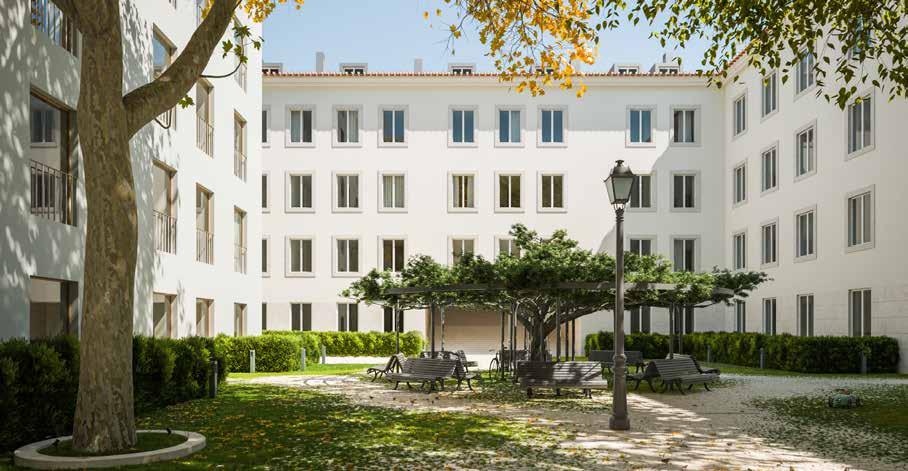
Lead Story
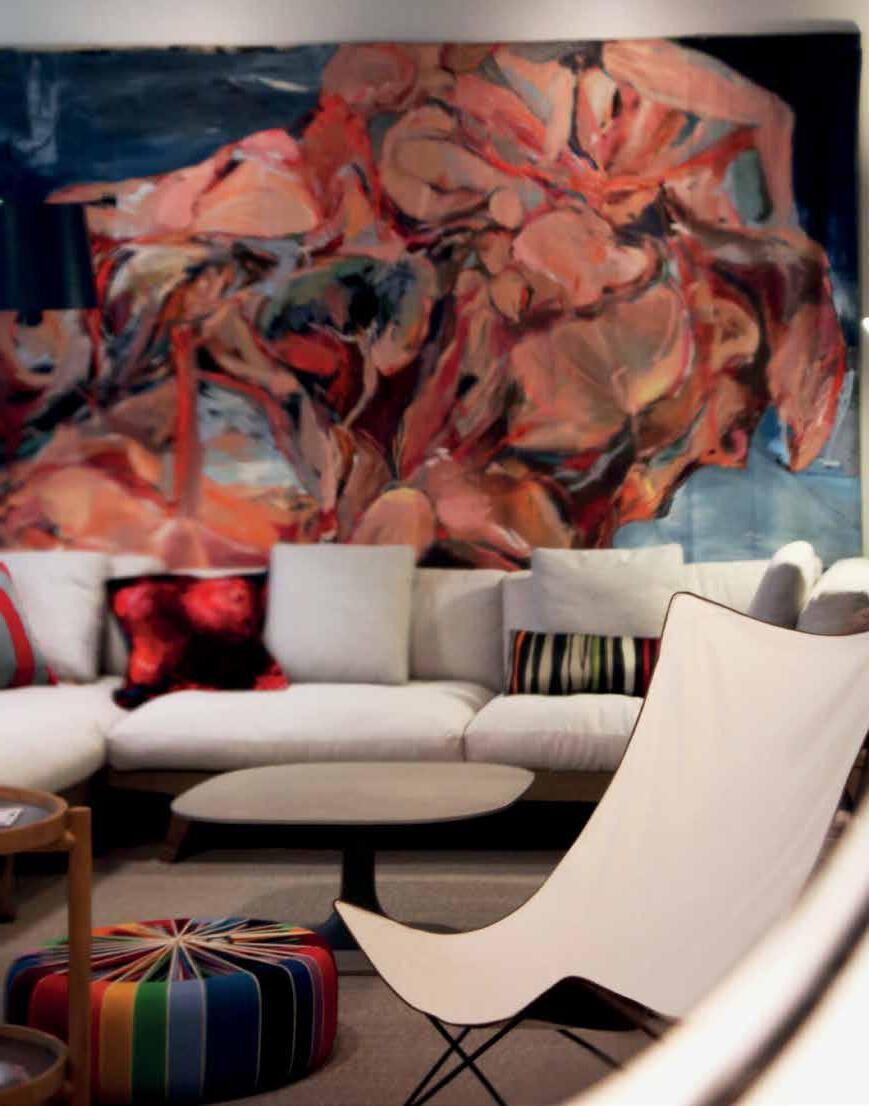
Tema
Dar carácter às áreas urbanas
Giving character to urban áreas
Ainda que volátil, consoante as tendências e os ciclos económicos (e outros), o imobiliário continua a ser um bom refúgio - dizem os especialistas. Mas numa época em que se constrói, bem e de forma cada vez mais sustentável, e em que todos têm acesso à mesma informação, como se pode diferenciar um profissional e um activo num mercado altamente competitivo? Whilst volatile, depending on trends and economic cycles (and others), real estate continues to be a safe haven say specialists. But in an age when developers build well and in an increasingly more sustainable way, and when everyone has access to the same information, how can you tell the difference between a professional and an asset in a highly competitive market?

O imobiliário está em tudo e em todo o lado. No mercado português tornou-se altamente qualificado e profissional qualquer que seja o segmento em que actua. Mas o acesso à informação banalizou-se, pois todos recorrem às mesmas fontes.
Então, se o imobiliário português é bom, estético e continua no radar dos investidores nacionais e estrangeiros (não obstante os actuais desafios legislativos, fiscais, económicos, internacionais), como é que se pode diferenciar num mercado tão competitivo?
Identificar requer apenas pesquisa Os especialistas apontam várias teorias para um profissional que opera no imobiliário se diferencie dos demais, seja um investidor, promotor, consultor, arquitecto, construtor, mediador…
A primeira de todas é: Informação. Hoje tudo está à distância de um simples clique, tudo é de fácil acesso. No entanto, quanto mais acessível for a informação, maior vai ser a dificuldade em se acrescentar valor. É, precisamente, nesse valor que reside a diferenciação.
A matéria-prima de quem opera no mercado imobiliário é a informação que se tem sobre as empresas, fundos, activos, público, privado, dados estatísticos, conjunturas, tendências, gostos, necessidades…, do cruzamento destas informações resulta o valor que se pode acrescentar por se estar neste mercado.
Não foi há muitos anos que se passou da máxima “o segredo é a alma do negócio” para um
presente em que rapidamente um negócio chega aos ouvidos de todos. Onde se conhece a natureza do negócio, o vendedor e o comprador, e que é, em escassos segundos - porque vivemos na era do digital e da conectividadeamplamente difundido nas redes sociais.
A verdade é que não está mais fácil fazer negócios imobiliários, não só porque há mais profissionais a trabalhar nesta área, mas porque também a informação está muito acessível a todos. Isso eleva o nível de exigência para acrescentar valor e, para tal, as empresas e os profissionais têm de ser mais criativos. Além da informação e da criatividade, ser uma superbrand ou uma marca autêntica também podem ser factores diferenciadores. Em Portugal, o imobiliário tornou-se mais profissional, mas também mais competitivo, razão pela qual é vital estabelecer uma marca com uma forte presença no mercado, ao ponto de estabelecer uma relação de confiança e de se tornar na escolha óbvia ou única na hora de fazer um negócio imobiliário.
Mas é preciso ir um pouco mais além. É necessário personalizar serviços e oferecer experiências excepcionais, ou seja, ir directamente à mente e ao coração de cada cliente. O Marketing aqui funciona muito bem. Mas é preciso ter sempre presente a ideia de que, para ser uma marca, produto ou serviço bem-sucedidos é preciso um trabalho, esforço, monotorização e adaptação contínuos. “Baixar os braços” ou “dormir à sombra dos louros” está fora de questão. Num “piscar de olhos”, o mundo
muda e o imobiliário muda também.
Investir em imóveis tornou-se num verdadeiro desafio uma vez que todos, desde que tenham capital (próprio ou bancário) são investidores imobiliários e agora, graças às novas tecnologias, já nem precisam de sair de casa para visitar um imóvel. Diferenciar-se dos outros requer, pois, apenas um pouco de pesquisa.
Abordagem holística
Porque os “olhos também comem”, cada vez mais o imobiliário em Portugal está original, belo, sexy e cativa investidores, empreendedores, talento e compradores (mesmo com os actuais preços praticados no nosso País).
A Landscape Architect Associate na Broadway Malyan, Lydia las Casas, diz-nos que “no competitivo cenário imobiliário, a diferenciação é crucial.” E esclarece porquê: “Um projecto de arquitectura paisagista de qualidade transcende as fronteiras tradicionais do desenvolvimento imobiliário, exigindo uma abordagem holística que vai além da mera ecologia e estética.”
Na sua opinião, a “primeira impressão de qualquer empreendimento é frequentemente a mais duradoura, e a arquitectura paisagista desempenha um papel fundamental em provocar uma reacção emocional, transformando espaços obsoletos em lugares memoráveis.” E dá como exemplo as praças e os espaços públicos criteriosamente projectados, tal como
a envolvente da requalificada Estação do Rossio, em Lisboa, ou no espaço central do World of Wine, em Gaia, nos quais a arquitecta esteve envolvida e que “surgem como pontos focais que definem o carácter de toda uma área urbana, tornando-se pontos de encontro para a comunidade, catalisando a vivência e interacção social.”
Lydia las Casas destaca ainda a integração de elementos da arquitectura paisagista – a Biophilia. “A sua integração em projectos de escritórios, como o Porto Office Park ou o EXEO Office Campus em Lisboa, ou em projectos residenciais, como o Fábrica 1921, não
proporciona apenas um melhor ambiente de trabalho e uma maior qualidade de vida, como também aumenta significativamente a atractividade do projecto para potenciais clientes.”
A CEO e directora da Criativa do Atelier Ana Rita Soares Interior Design acrescenta a esta visão o Design de Interiores que, como defende, “eleva o valor dos activos”.
A firmeza das palavras de Ana Rita Soares revela que “num mercado cada vez mais competitivo, o Design de Interiores desempenha através da inovação e sustentabilidade um papel crucial na valorização de activos imobiliários.” Acreditando que “a sua excelência

A primeira impressão de qualquer empreendimento é frequentemente a mais duradoura, e a arquitectura paisagista desempenha um papel fundamental em provocar uma reacção emocional.
The first impression of any development is frequently the most long lasting, and the landscape architect has a vital role to play in provoking an emotional reaction.”



é factor decisivo na diferenciação, funcionalidade e estética, para elevar o valor dos activos colocando-os estrategicamente num nicho valioso da indústria imobiliária.”
Mas Ana Rita Soares faz a ressalva para o facto de que o “design no contexto habitacional, deve reflectir o estilo de vida dos ocupantes proporcionando-lhes a funcionalidade esperada através da selecção criteriosa e consciente de materiais (estética, ambiental e fi-
nanceira).” É que, segundo a sua experiência, “nas empresas e hotelaria, através das cores, ergonomia ou funcionalidade cria ambientes mais produtivos e inovadores, potenciando a experiência, os bons resultados dos colaboradores, e a criação de vivências memoráveis para clientes e hóspedes.”
Imobiliário disruptivo
Está mais difícil fazer negócio? Está, já o dis-
mortgages on the up
Em Janeiro, de acordo com a AICCOPN - Associação dos Industriais da Construção Civil e Obras Públicas, verificou-se um acréscimo homólogo de 24,7% no volume de novo crédito à habitação, excluindo renegociações, concedido pelas instituições financeiras, que totalizou 1.184 milhões de euros.
No que concerne à taxa de juro implícita no crédito à habitação fixou-se em 4,66%, nesse mês, o que traduziu um aumento de 2,47 pontos percentuais, face ao verificado no mesmo mês do ano anterior.
A associação refere ainda que relativamente ao valor mediano de avaliação de habitação para efeitos de crédito bancário, em Janeiro, observou-se uma valorização de 4,4%, em termos homólogos, em resultado de variações de 3,2% nos apartamentos e de 6.1% nas moradias.
In January, according to AICCOPNAssociation of Civil Construction Industries and Public Works, there was a 24.7% like-for-like increase in the amount of new home mortgages, excluding renegotiations, granted by credit institutions that totalled 1.184 billion euros.
Regarding the interest rates implicit to mortgages this was set at 4.66% that month, which means an increase of 2.47 percent compared like-for-like on 2022. The association also refers that relative to the average housing valuation for the effects of bank mortgages, in January, there was an appreciation of 4.4% in like-for-like terms, because of variations of 3.2% for apartments and 6.1% for houses.

VICTORIA - Seguros, S.A. (NIPC 506 333 027) e VICTORIA - Seguros de Vida, S.A. (NIPC 502 821 060) En�dades legalmente autorizadas para a exploração de seguros dos Ramos «Não Vida» e «Vida» em Portugal, registadas junto da Autoridade de Supervisão de Seguros e Fundos de Pensões de Portugal, sob os códigos 1160 e 1096, respe�vamente. Capital Social EUR 34.850.000 e EUR 8.500.000, respe�vamente. Av. da Liberdade, 200 - 1250 -147 Lisboa - Portugal. Telf. 21 313 41 00 (Custo de uma chamada para a rede fixa nacional) - Dias úteis das 08h30 às 18h30 Não dispensa a consulta da informação pré-contratual e contratual legalmente exigida. www.victoria-seguros.pt Trabalhamos hoje para que o amanhã exista.

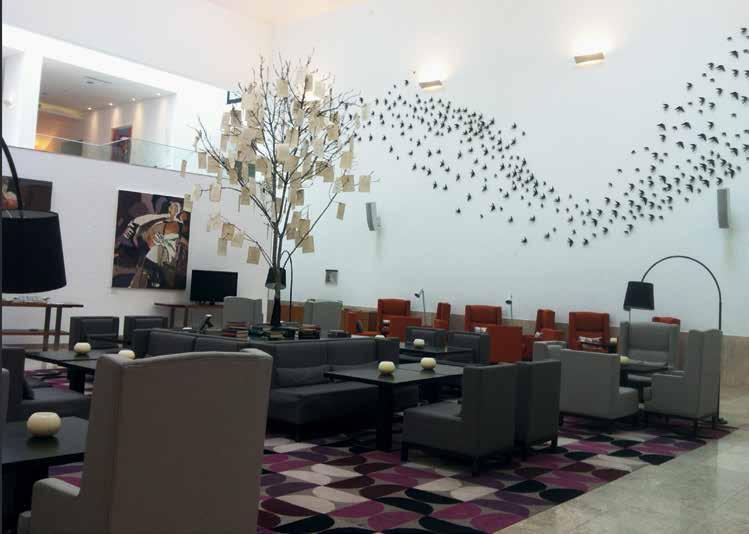
semos. Mas também está cada vez mais fácil encontrar empreendimentos de elevada qualidade no nosso País.
Por isso mesmo, observámos, no final de 2023, que o investimento imobiliário português se cifrou nos 1.6 mil milhões de euros. É certo que é um valor mais baixo do que o registado em 2022; ainda assim, tudo leva a crer, que poderá recuperar em 2024, haja um decréscimo das taxas de juro e um aumento dos índices de confiança dos players imobiliários. Este é um dos sectores que nos faz literalmente andar de cabeça no ar, no meio da rua, a olhar para os edifícios construídos ou reabilitados das nossas cidades. É também um dos sectores que mais nos faz “deitar contas à vida”.
Ao mercado têm chegado soluções alternativas ao imobiliário tradicional, mais económicas, mais rápidas e mais sustentáveis. A título de exemplo, a empresa Havelar recolheu materiais como argilas, cinzas, lamas, escórias,
saibros, argila expandida, britas, areias, gessos, ligantes, óxidos, fibras e cascas de arroz - ingredientes que são considerados “lixo” pelas construtoras - e que a empresa utiliza nas suas misturas, procurando adequá-las à técnica construtiva e desencadear, desta maneira, um processo de economia circular no sector. Apostaram em casas edificadas com impressoras 3D e têm como meta baixar o nível de CO2 das construções em 50%.
Diz-se, no entanto, que a oferta de terrenos e imóveis é escassa para tanta procura. O que nos leva a questionar: É a nossa percepção do que procuramos, idealizamos ou sonhamos que dita a diferenciação e a aquisição de um imóvel, ou são os imóveis que chegam ao mercado que manipulam os nossos gostos, desejos e possibilidades?
Quer parecer que, em última instância, é a qualidade e a quantidade de informação que está a tornar o imobiliário nacional mais competitivo, mais disruptivo e mais atractivo.
Ao mercado têm chegado soluções alternativas ao imobiliário tradicional, mais económicas, mais rápidas e mais sustentáveis.
Alternative but more economic, faster to build and more sustainable solutions to traditional real estate have come onto the market.”

Com mais de 24 anos de experiência e uma equipa altamente qualificada, a Rockbuilding atua na transformação de espaços urbanos, e conta com intervenções em mais de 6 milhões de metros quadrados.
Estando no centro da gestão de projetos, apoia empresas e instituições em todas as fases da gestão do seu património imobiliário, oferecendo soluções personalizadas que promovem o desenvolvimento sustentável, a otimização de custos e o cumprimento da qualidade.
Real estate is in everything and everywhere. In the Portuguese market it has become highly qualified and professional regardless of the segment in which it operates. But access to information has become old hat since everyone uses the same sources.
So, if Portuguese real estate is good, beautifully designed, and continues to attract national and international investors (despite the current legislative, fiscal, economic, and international challenges), how can you stand out in such a competitive crowd?
Identifying simply requires research
The specialists point to several theories for a professional operating in real estate to stand out from the rest, be they investors, consultants, architects, builders, or estate agents. First and foremost is Information. Today, everything is just a simple click away and easy to access. However, the more accessible the information is, the more difficult it will be to add value. And it is in adding value that differentiation comes in.
For anyone operating in the real estate market, the raw material is the information you have on companies, funds, assets, the public and private sectors, data, statistics, the economic backdrop, trends, tastes, requirements..., by cross-referencing this information you get the value that can be added from being in this market.
It was not too many years ago that you had the maxim ‘The secret of business is to know something that nobody else knows’ whereas

today a business idea is quickly on the tip of everyone’s tongues. You can find out the nature of a business - both the seller and the buyer, in a few seconds because we live in a digital and internet connected world where information is widely disseminated on social networks.
The truth is that it is not easier to do real estate deals, not just because there are more professionals working in this area, but because the information is easily accessible to all. This raises the benchmark requirement where you must add value, and for that companies and professionals need to be more creative. Apart from information and creativity, becoming a superbrand or authentic brand can also be differentiating factors. In Portugal, real estate has become more professional, but also more competitive, which is why it is vital to establish a brand with a strong presence in the market, to the point of establishing a relationship of trust and becoming the obvious and sole choice when the time comes to strike a real estate deal.
But you have to go the extra mile. You should offer personnel services and exceptional experiences. In other words, go directly to the mind and heart of each client. Here marketing works very well. But you always must bear in mind the idea that to become a successful brand or service takes hard work, and continuous monitoring and adaptation. Folding your arms and getting complacent is out of the question. In the blink of an eye the world changes and real estate too.

Em que ficamos?
Where we are now
Em nome da transição
In the name of energy transition
A emergência climática exige que se proceda a uma redução de emissões de carbono e se aposte em serviços ecológicos. Até aqui tudo bem.
O problema surge quando passa a existir um aumento de unidades centralizadas de produção fotovoltaica e outras infra-estruturas, sem a devida avaliação de alternativas de localização, e com isso assiste-se ao abate de milhares de árvores, nomeadamente espécies protegidas.
Só para se ter uma noção, a central solar Fernando Pessoa projectada para Santiago do Cacém, a maior da Europa, engloba um projecto de 1.200 hectares e o corte de 1,5 milhões de árvores. Já no projecto do Fundão, está previsto o abate de uma área constituída por carvalho negral, o habitat natural das cegonhas brancas.
O País anda a correr a contra-relógio para cumprir as metas ambientais europeias. Mas a que custo?
The climate emergency requires us to move forward with reducing carbon emissions and invest in ecological services. So far, so good.
The problem arises when there is an increase in centralised photovoltaic production units and other infrastructures, without the proper evaluation of alternative location, and with it the felling of thousands of trees, particularly protected species.
So, to have an idea, the Fernando Pessoa solar park planned for Santiago do Cacém, the largest in Europe, involving a 1,200-hectare project and the felling of 1.5 million trees. Then in the project in Fundão the felling of an area made up of Pyrenean oak, the natural habitat of the white storks.
The country is running against the clock to meet European environmental targets. But at what cost?
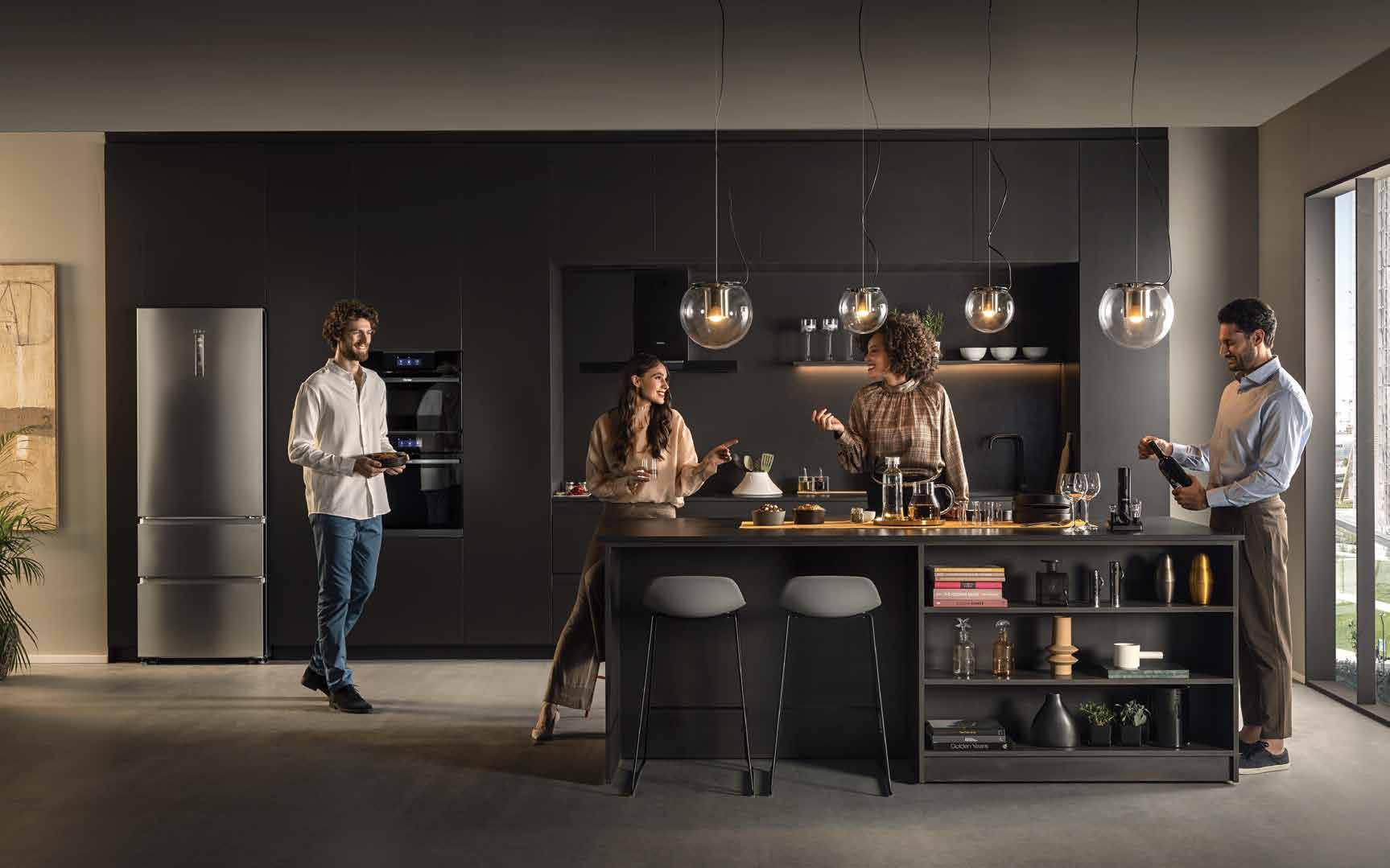
Investing in property becomes a real challenge since everyone, from those who have (own or bank loan) capital are real estate investors and now, thanks to new technologies, you no longer need to leave the house to view a property. Standing out from the others indeed requires only a little research.
Since property can also be a ‘feast for the eyes’ real estate in Portugal has increasingly become more original, beautiful, sexy, and attracts investors, entrepreneurs, talent, and buyers.
(even at the current market prices in Portugal) The Landscape Architect Partner at Broadway Malyan, Lydia las Casas tell us that “in the competitive world of real estate differentiation is crucial.” And makes clear why: A quality landscaped architecture project transcends traditional real estate development borders, requiring a holistic approach that goes beyond mere ecology and philosophy.”
In her opinion, the “first impression of any development is frequently the most long lasting, and the landscape architect has a vital role to play in provoking an emotional reaction, transform-
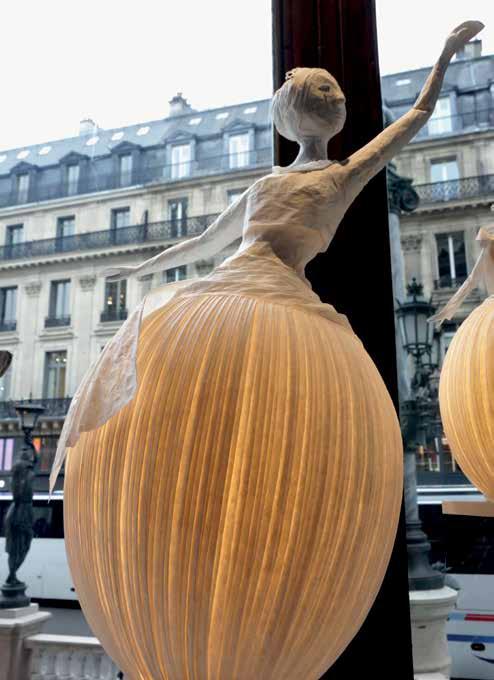
A associação ambientalista ZERO faz algumas observações ao novo Governo em matéria de ambiente e sustentabilidade:
• No Ministério do Ambiente e Energia lamenta o facto da “Conservação da Natureza ter perdido a titularidade enquanto Secretaria de Estado”;
• Já no caso da pasta da Energia, “a titular do cargo apresenta uma sólida experiência académica na área tutelada”;
• No caso das Florestas “lamenta” a alteração da “titularidade do dossier”, que, recorde-se, passa a de novo a Ministério da Agricultura e Pescas e na opinião da ZERO “representa um passo atrás em termos da valorização das diferentes valências da floresta”;
• De “saudar” é a “manutenção da Secretaria de Estado do Mar.”
A ZERO salienta, no entanto, que dá “o benefício da dúvida” e que “só a acção concreta permitirá conhecer as reais capacidades de cada um.”
The environmental association ZERO has made some observations to the new government on the matter of environment and sustainability.
• At the Ministry of the Environment and Energy it regrets the fact that there is no longer a Secretary of State for “Nature Conservation”;
• In the case of the energy portfolio, “the post holder has a solid academic experience in the area governed”;
• In the case of forests “it regrets the change to the “name of the portfolio,” which it reminds has again changed to the Ministry of Agriculture and Fisheries and in the opinion of ZERO, represents a backward step in terms of valuing the different aspects of forestry;”
• To be welcomed is the “retaining of the Secretary of State of the Sea.”
ZERO stresses, however, that it gives the “benefit of the doubt” and that only concrete action will establish the actual capacities of each one.”
A qualidade e a quantidade de informação está a tornar o imobiliário nacional mais competitivo, mais disruptivo e mais atractivo.
Quality and the amount of information that is making Portuguese real estate more competitive, but disruptive and more attractive.”
ing obsolete spaces into memorable places. And gives as an example carefully designed squares and public spaces, such as the area surrounding Rossio train station which was refurbished and landscaped, or the central area of World of Wine in Gaia (Porto) in which the architecture was involved and where the buildings are focal points that define the character of the entire urban area, becoming meeting points for the community, spurring social interaction and living.”
Lydia las Casas also highlights the integration of elements of architecture in the landscape – known as Biophilia. “This integration in office projects, such as Porto Office Park or EXEO Office Campus in Lisbon, and other residential projects such as Fábrica 1921, not only provides a better working environment and a greater lifestyle quality, but also significantly increases the attractiveness of the project for potential clients.”
The CEO and director of CEO Atelier Ana Rita Soares Interior Design adds to this vision Interior Design which, she argues, “raises the value of the assets.”
The conviction in Ana Rita Soares’s words reveals that “in an increasingly more competitive market, Interior Design performs; through its innovation and sustainability; a crucial role in real estate assets adding and retaining value.” Believing “its excellence is a decisive factor in differentiation, functionality and aesthetics, to increase the value of assets, placing them strategically in a valuable niche in the real estate industry.”
But Ana Rita Soares stresses the fact that “design in the housing context should reflect the lifestyle of the occupants, providing them with the functionality expected through the select and conscious use of the materials (aesthetics, environmental and financial).” And that in her experience, in companies and hotels, the use of colours, ergonomics and functionality creates more productive and innovative environments, enhancing experience, good staff results, and the creation of memorable life experiences for clients and guests.”
Is it more difficult to do deals? It is, as we have said. But it is increasingly easier to find high quality developments in Portugal. For precisely this reason, we saw that at the end of 2023 investment in Portuguese real estate brought in 1.6 thousand million euros. Certainly, it is a lower amount than registered in 2022; nevertheless, everything leads you to believe that it could recover in 2024 if interest rates

come down, and there is an increase in the confidence of real estate players.
This is one of the sectors that has us literally wandering down the middle of the street looking up at our cities’ buildings that have been built or refurbished. And it is also one of the sectors that most makes us reflect upon life. Alternative but more economic, faster to build and more sustainable solutions to traditional real estate have come onto the market. By way of example, the company Havelar collected materials such as clays, muds, slag, expanded clay, gravels, sands, plasters, binders, oxides, rice husks and fibres - ingredients that are considered ‘rubbish’ by most builders - and which the company uses in mixes, looking to adapt them to building techniques, and in this way instigate the circular economy process in the sector. They have Invested in houses built with 3D printers with a target of reducing the level of CO2 in construction by 50%.
The company tells us, meanwhile, that the supply of parcels of land and property is scarce for so much demand. And this leads us to ask: It is our perception that we seek, idealise or dream of that differentiation when buying property, or is it that the properties that come onto the market manipulate our tastes, desires, and possibilities?
It seems that at the end of the day it is quality and the amount of information that is making Portuguese real estate more competitive, but also disruptive and more attractive.
The Big Interview
 Vencedor Melhor
Vencedor Melhor
Empreendimento do Ano
Winner Best Development of the Year
“For the neighborhood”
A Escola Básica + Jardim Infantil nº125
Arquitecto Gonçalo
Ribeiro Telles triunfou na cerimónia do Prémio Nacional do Imobiliário 2024, tendo recebido o troféu de “Melhor Empreendimento do Ano”. Gonçalo Santos Costa, presidente da Lisboa Ocidental SRU, empresa municipal promotora desta obra, levou-nos à escola, onde nos explicou os “porquês” que levaram a esta distinção.
The Reception School + Kindergarten Nº125
Architect Gonçalo Ribeiro Telles triumphed at the ceremony of the Portuguese Real Estate Awards 2024, having won the trophy for the “Best Development of the Year”. Gonçalo Santos Costa, President of the West Lisbon SRU, the municipal development company for this project, took us ‘back to school’, where he explained to us the “whys and wherefores” that led to this award.

Como sente esta premiação de um espaço educativo promovido por uma entidade municipal?
Ficámos muito felizes. É preciso perceber que esta escola teve um investimento de cerca de 13 milhões de euros, representando o maior investimento alguma vez feito numa nova escola pública do ensino básico e por uma empresa municipal.
Depois, é uma escola que enquadra o programa de regeneração urbana do bairro da Boavista, na freguesia de Benfica, que foi construído em 1940 com cariz social, mas que, ao longo dos anos, se foi degradando e perdendo valências.
Agora vai ficar preparada para acolher 280 alunos, com salas de jardim de infância, oito salas para o 1º ciclo, anfiteatros e ginásios interiores, espaços de aprendizagem, de lazer, de brincadeira, de contacto com a comunidade e inclusivo, uma vez que detém salas e acessos para crianças portadoras de multideficiências.
Sem esquecer o espaço verde com ligação a Monsanto e as hortas que acabam por ter um papel de educação ecológica. É também uma singela homenagem ao arquitecto paisagista Gonçalo Ribeiro Telles.
A Lisboa Ocidental SRU encontra-se envolvida em outras escolas, mas apenas esta é nova e não reabilitada. Isso deu-vos “asas para voar”?
Ter sido criada de raiz permitiu, de facto, fa -
zer um uso maior que a própria escola e trazer novas valências para dentro das portas escolares, como é o caso da música. O bairro já possuía a Orquestra Geração, que tem sabido captar talentos na juventude local, e que agora tem a oportunidade de se mostrar no anfiteatro aos fins-de-semana, além da aprendizagem nas seis salas isoladas que existem para o ensino da música.
Os pavilhões desportivos vão também abrir-se à comunidade local, podendo, aos fins-de-semana, os pais acompanharem os seus filhos na prática do futebol.
No redor da escola decidiu-se aumentar as valências, como é o caso da habitação, estando em construção 90 fracções, a edificação de uma igreja, que foi demolida no contexto desta obra, uma praça de carácter público e uma creche.
Este é um empreendimento do bairro para o bairro, moderno, que tem por objectivo ser o ponto de encontro da comunidade.
Em 2025 a SRU vai celebrar 20 anos de actividade. É bom ver, ouvir e sentir os espaços que criam ao longo dos tempos ocupados?
Inicialmente eram cinco sociedades de reabilitação urbana, mas, em 2018, uma alteração estutária levou a que somente ficasse a Lisboa Ocidental, extinguindo-se todas as outras.
Desta forma passou a ter uma acção em toda a área de Lisboa e em toda a regeneração da

cidade em quatro áreas distintas: habitação, equipamentos sociais e escolares, e espaços públicos.
Desde 2021 participa em vários empreendimentos de habitação a renda acessível, nomeadamente em Entrecampos e Marvila, num total de sete empreitadas com cerca de 900 fogos já executados ou a executar até 2026. Além da intensa actividade em escolas, creches e jardins de infância, unidades de saúde e intervenções na via pública, bem como espaços sociais e culturais, dos quais destaco a reabilitação e remodelação complexa do MUDE e o Pavilhão Desportivo de Marvila.
Com pouca gente, somos apenas 100 trabalhadores, fazemos muito, com cerca de 30 intervenções que realizamos por ano. E sim, dá-nos um enorme gozo ver as crianças a usufruir das escolas, as pessoas a serem atendidas nas unidades de saúde, os lisboetas a habitar em Entrecampos, é para elas que trabalhamos.
Qual a obra que a SRU ainda não fez e gostava que fosse concretizada?
Algo que me preocupa e que gostava de ver alterado no futuro seria a ligação de Lisboa com o Rio. Gostava de ver a frente ribeirinha mais desimpedida e sem o obstáculo da presença dos contentores. Eventualmente também a eliminação da linha férrea. Mas são obras que têm de ser bem pensadas.
How do you feel having won this award for this education space developed by a municipal body?
We are very happy. You should know that this school received investment of around 13 million euros, representing the largest investment ever made on a new public primary education school and the largest one by a council company.
Then, it is a school that is part of the Boavista neighbourhood urban regeneration programme in the parish of Benfica, which was
Este é um empreendimento do bairro para o bairro, moderno, que tem por objectivo ser o ponto de encontro da comunidade. This is a modern development of the neighbourhood for the neighbourhood whose objective is to be a meeting point for the community.”
built in 1940 as social housing, but which over the years became run down and was losing facilities.
Now it will be made ready to welcome 280 pupils, with kindergarten rooms, eight rooms for the primary levels, auditoriums and indoor gyms, areas for learning, leisure, play, and inclusive community contact given they have rooms and accesses for kids with different disabilities.
And this is not to mention the green space with a link to Monsanto and the vegetable plots that now have a role in ecological education. It is also a singular tribute to the architect Gonçalo Ribeiro Telles.
Lisbon West SRU is involved in other schools, but only this one is new and not refurbished. Has this given you an appetite to do more?
Having been created from scratch has enabled more use to be made of the school itself, and bring in new subjects to the schools, such as music. The neighbourhood now possesses the Generation Orchestra that has been able to attract local youth talent, and now can put on performances at the weekends, in addition to
six sound proofed rooms for music teaching. The sports pavilions will also be open to the local community, so that parents will be able to join their kids playing football at the weekends.
In the surroundings of the school, it was decided to increase valencies, as is the case with housing, with 90 apartments being built as well as a church, which was demolished as part of this project, and a public square and crèche. This is a modern development of the neighbourhood for the neighbourhood whose objective is to be a meeting point for the community.
In 2025, the SRU will celebrate 20 years of activity. Is it good to see, hear and feel the spaces they have created become occupied. Initially, there were five urban rehabilitation companies, but in 2018, a change in statutes had led to only Lisbon West remaining after the others were wound up. So now it will operate for the whole Lisbon area, and all the city’s regeneration in four distinct areas: housing, social amenities and schools, and public spaces. Since 2021, it has been involved in housing for
affordable rent, namely in Entrecampos and Marvila, with a total of 900 homes already built or to be built to 2026. In addition to intense activity in schools, there have been projects for crèches and a kindergarten, health centres and public road and pathway projects, as well as social and cultural spaces of which I would highlight the renovation and refurbishment of the MUDE complex and the Marvila Sports Pavilion.
With few people - and we are only 100 - we do a lot; around 30 projects or so a year. And yes, it gives us an enormous sense of satisfaction to see the children use the schools, people being attended in the healthcare centres, the Lisboners living in Entrecampos, and for those for whom we are working.
Which SRU project that you have not done would you most like to see built?
Something that concerns me that I would like to see changed in the future would be the link between Lisbon and the river. I would like to see the river front less cluttered and without the shipping containers. Eventually too, I would like to see the railway line eliminated. But these are works that must be well thought out.
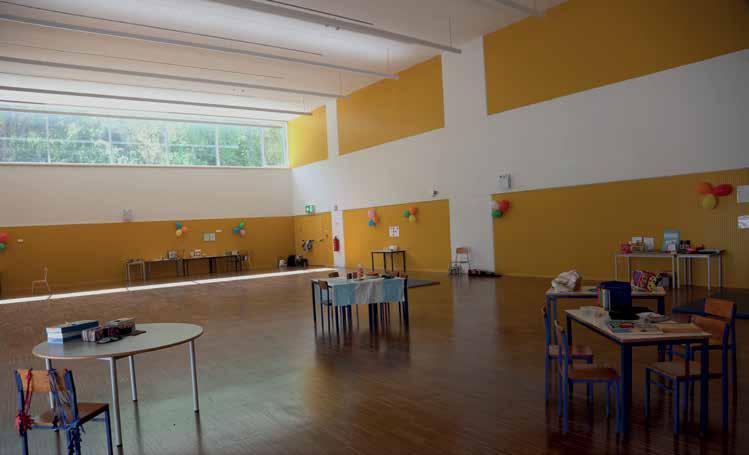

Originalmente já existia uma escola neste local que acabou por ser demolida e do nada se fez uma nova e que é um verdadeiro exemplo a seguir.
“Inserida num bairro socialmente difícil” a premissa foi, segundo o arquitecto João Santa-Rita, “criar uma escola mais confortável e mais aberta à comunidade”. Com uma concepção “complexa”, foi sendo “moldada com diferentes valências” e “apoiada pela paisagem de Monsanto”.
O arquitecto Paulo Palma diz-nos que fazem “projectos de qualidade independentemente do fim a que se destina”, e esta escola não foi excepção. Trata-se de uma escola passiva do ponto de vista energético, onde todos os espaços têm iluminação directa, acesso a vistas exteriores, ventilação natural e térmica estável, tal faz com que, “independentemente dos materiais ou acabamentos utilizados, sejam
factores diferenciadores e isso é algo que as crianças, que os utilizadores, sentem.”
Como João Santa-Rita evidencia: “Há sempre uma relação com o ar livre, com o céu, com o verde da mata, com a natureza, é algo bom, psicológico que faz a diferença”.
A arquitecta paisagista Luísa Branco, sublinha que neste projecto “aquilo que poderia ser um entrave, transformou-se numa oportunidade”, ou seja, “o facto de estar na linha protegida do parque florestal, que limitava a intervenção, acabou por permitir trazer Monsanto para dentro da escola e um maior contacto com o meio ambiente.”
Já o gestor de contrato de empreitada da SRU Elídio Jesus confessa-nos que o que mais gostou neste projecto foi o facto de “ser fora do vulgar, quer nos espaços exteriores, quer interiores”, de “ser bonito sem se ter cingido ao standard”, ter sido “pensado para a comu-
nidade escolar e para o próprio bairro” e ainda conseguir “chamar a população para lá do bairro para assistir a eventos”.
Esta é uma escola que, efectivamente, serve a comunidade local e que simultaneamente extravasa as suas fronteiras.
There had originally been a school in this area that was torn down and a new one was created from scratch, which is a true example to follow.
“Placed in a socially complicated neighbourhood” the premise was, according to the architect João Santa Rita, to “create a more comfortable school that is more open to the community.” With the conception of a “complex” the “different valences were moulded” and “enhanced by the Monsanto Park landscape.”
The architect Paulo Palma tells us that he does “quality projects regardless of their final use,” and this school was no exception. This is an efficient school from an energy point of view, where all of the spaces have direct lighting, access to views of the surrounding area, natural ventilation and stable temperatures, which means that regardless of the materials and finishes used, they are differentiating factors, and this is something that makes the children who use them feel well.”
As João Santa Rita reveals: “There is always a relationship with the open air, the sky, the green vegetation, and with nature, which is always good and psychologically makes a difference.”
The landscape architect Luisa Branco emphasises that on this project “something that could have proved an obstacle, ended up by being an opportunity”, in other words “the fact that it is on the edge of the protected Monsanto forest park, which restricted the development, has enabled Monsanto to be brought into the school, creating a greater contact with the surrounding environment.”
The SRU building contract manager, Elídio Jesus admits to us that what he most liked about the project was the fact of it being “unusual” both in terms of outdoor and indoor spaces being “attractive without having to be restricted to the standard”, having been thought out with the school community in mind, and for the neighbourhood itself” and also able to “attract people living outside of the neighbourhood to partake in events”. This is a school that effectively serves the local community and at the same time transcends its borders.

 Director de Sustentabilidade e Mobilidade da ADENE
Director of Sustainability and Mobility at ADENE - Agency for Energy
Director de Sustentabilidade e Mobilidade da ADENE
Director of Sustainability and Mobility at ADENE - Agency for Energy
O PEES assume, portanto, um papel crucial como um instrumento de política pública para a promoção da sustentabilidade no sector imobiliário. Ao destacar e premiar os melhores exemplos de práticas sustentáveis, este prémio não só reconhece líderes na transição energética e climática, mas inspira igualmente outros a seguir o exemplo. Esta visibilidade e distinção impulsionam a adopção generalizada de medidas sustentáveis, não apenas como uma escolha ética, mas também como uma estratégia comercial viável.
dates received reflects a growing awareness and commitment on the part of the candidates.
Increasingly, the candidates not only meet high energy performance requirements, but also address the efficient and sustainable use of resources such as water and materials, which is reflected in the improved quality of life of the occupants and communities.
O Prémio de Excelência em Eficiência & Sustentabilidade (PEES) da revista “Magazine Imobiliário” emerge como um catalisador crucial na promoção de critérios e métricas de sustentabilidade no sector da promoção imobiliária em Portugal.
Este ano, a significativa quantidade e qualidade das candidaturas recebidas reflectem uma crescente consciência e compromisso por parte dos participantes. Cada vez mais, os candidatos não só cumprem os requisitos de desempenho energético elevado, como também abordam o uso eficiente e sustentável de recursos como a água e os materiais, que se reflecte na melhoria da qualidade de vida dos ocupantes e comunidades.
Além disso, está alinhado com as directrizes e regulamentações europeias em rápida evolução na área da sustentabilidade. Instrumentos como a Taxonomia Verde Europeia, a Directiva de Relatórios de Sustentabilidade Corporativa e o Regulamento de Divulgação de Finanças Sustentáveis estão a moldar o ambiente regulatório, tornando a sustentabilidade não apenas desejável, mas também uma exigência para operar no mercado. Em suma, o PEES não é apenas um prémio, mas sim um impulsionador fundamental da transformação do sector imobiliário português em direcção a práticas mais sustentáveis. Ao reconhecer e promover os líderes nesse campo, contribui significativamente para a adaptação do mercado à crescente procura por sustentabilidade, enquanto impulsiona uma mudança cultural em direcção a um futuro mais sustentável e resiliente. Magazine Imobiliário’s Award for Excellence in Efficiency & Sustainability (AEES) has become a crucial catalyser in encouraging sustainability criteria and metrics in real estate development in Portugal. This year, the significant quantity and quality of the candi-
The AEES has therefore a crucial role as an instrument of public policy for the promotion of sustainability in the real estate sector. By highlighting and distinguishing the best examples of sustainable practices, this award not only recognises leaders in energy transition and climate, but equally inspires others to follow the example. This visibility and distinction have driven an across-the-board adoption of sustainability measures, not just as an ethical choice, but also as a viable commercial strategy.
Moreover, it is aligned with European directives and regulations in rapid development in the area of sustainability. Instruments such as European Green Taxonomy, the Corporate Sustainability Reports Directive and the Sustainable Finances Reporting Regulation are moulding the regulatory environment, making sustainability not only desirable, but also a requirement to operate in the market.
In conclusion, the AEES is not just an award, but a fundamental driver in transforming the Portuguese real estate sector in the direction of more sustainable practices. By recognising and promoting leaders in this field, it has contributed significantly to the market’s adaptation to the growing demand for sustainability, while driving a cultural change in direction and a more sustainable and resilient future.

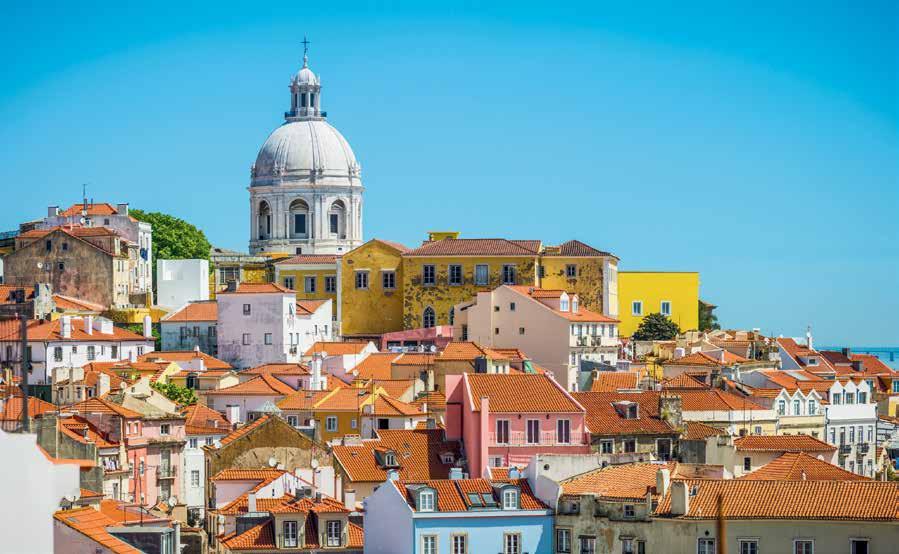

Junte-se à maior comunidade colaborativa com agentes imobiliários de 24 países para debater as tendências do setor imobiliário Saiba mais


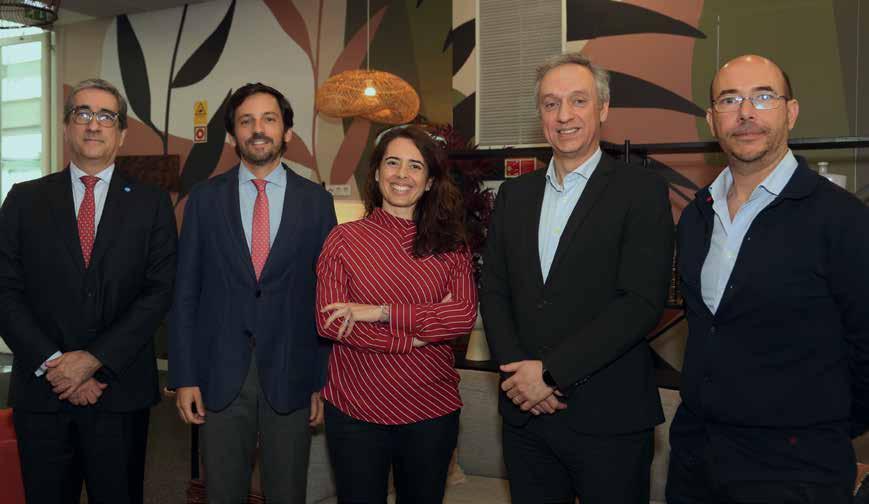
glory of public and private real estate

Como se pode ver na fotografia que ilustra este artigo, o Júri do Prémio Nacional do Imobiliário teve, uma vez mais, a difícil tarefa de escolher os melhores empreendimentos entre os melhores. Apesar dos debates “vivos” e de alguns elementos estarem presentes de forma “virtual”, imperou sempre uma salutar boa disposição. E as suas escolhas não foram óbvias!
A Escola Básica nº1 + Jardim Infantil Arquitecto Gonçalo Ribeiro Telles foi considerado pela esmagadora maioria dos Membros do Júri como o “Melhor Empreendimento do Ano 2024”, promovido pela Empresa Municipal Lisboa Ocidental SRU - Sociedade de Reabilitação Urbana. O empreendimento ganhou igualmente a Categoria de Empreendimentos Colectivos. Localizada no Bairro da Boavista, em Lisboa, na fronteira com o Parque de Monsanto, esta escola oferece apoio educativo à comunidade local, além de ser um espaço inclusivo e ambientalmente responsável.
Na Categoria de Escritórios triunfou a K-Tower Lisbon Business Centre do promotor Krest Real Estate Investments; e na Categoria Turismo o prémio foi atribuído ao Verdelago Resort, do promotor Verdelago Sociedade Imobiliária.
Na Categoria Habitação triunfou o Antas Atrium, do promotor Quest Capital. Esta, que foi a mais concorrida categoria dos “Óscares” do Imobiliário 2024, somando 22 Finalistas, levou à decisão, por parte da MAGAZINE IMOBILIÁRIO, de atribuir quatro prémios consoante a sua localização geográfica. Assim, os vencedores dos novos galardões foram: Prémio Habitação Norte – River Plaza do promotor Teixeira Duarte Real Estate; Prémio Habitação Centro – Miraflores Park do promotor SOLYD Property Developers; Prémio Habitação Sul – Bayline do promotor Vanguard Properties; e Prémio Habitação Ilhas – Savoy Residence I Insular do promotor Savoy Signature / AFA Real Estate. O Prémio Projecto de Interiores, o mais glamoroso de todos os prémios, foi concedido a Art Legacy Hotel, do promotor My Story Hotels e com o projecto de interiores de autoria do arquitecto Luís Rebelo de Andrade, Tiago Rebelo de Andrade, Pedro Duarte Silva e a equipa de Maria João Barcelos, Rita Serra e Silva, Raquel Jorge, Madalena Barreto. O Prémio Reabilitação coube ao empreendimento Rodrigo da Fonseca Prime Residences, do promotor Mexto Property Investment.
À semelhança da Categoria Habitação, o Prémio Reabilitação também reuniu um total de 22 concorrentes e, como tal, deliberou-se a atribuição de novas distinções: Prémio Reabilitação Norte foi para Grande Hotel Paris do promotor Just Stay Hotels; Prémio Reabilitação Centro foi para Duke Residences Saldanha do promotor Pujolinvest; e o Prémio Reabilitação Ilhas foi para o Barceló Funchal Old Town do promotor Emeraldtown – Empreendimentos Imobiliários e Turísticos. Para surpresa da organização também o Prémio de Excelência em Eficiência & Sustentabilidade, atribuído em parceria com a ADENE – Agência para a Energia, não só aumentou o número de empreendimentos a concurso, como revelou uma maior preocupação ambiental e energética com o edificado por parte dos promotores. O vitorioso foi o edifício de escritórios K-Tower Lisbon Business Centre do promotor Krest Real Estate Investments.
O Prémio Nacional do Imobiliário não se limita a reconhecer o trabalho dos players do sector, é, sobretudo, um incentivo para que produzam novas, melhores, inovadoras e sustentáveis criações urbanas. A Magazine imobiliário dá os “Parabéns a todos os Vencedores!”
As can be seen in the photograph that illustrates this article, the jury of the Portuguese Real Estate Awards once again found it a tall order to choose the best developments from among the best”. Despite the “heated” debates and some people assisting “virtually,” everyone was in a great mood and eager to discuss the projects. And their choices were not the obvious ones!
The Pre-School Nº 1 + Kindergarten Architect Gonçalo Ribeiro Telles was considered by the overwhelming majority of jury members as the ‘Best Development of the Year 2024’ in a project from the Lisbon City Council West SRU - Urban Rehabilitation Company. The development also won in the Collective Developments Category. Located in the Boavista neighbourhood in Lisbon, on the border with Monsanto Park, this school offers educational support at a community level, in addition to being an inclusive and environmentally responsible space.
In the Offices Category, K-Tower Lisbon Business Centre from developer Krest Real Estate Investments triumphed; and in the Tourism Category, the award went to Verdelago Resort from developer Verdelago - So -
ciedade Imobiliária.
In the Housing Category, Antas Atrium from the developer Quest Capital won. This, which was the most sought-after category of the Portuguese Real Estate ‘Oscars’ 2024, with 22 finalists, led to the decision by MAGAZINE IMOBILIÁRIO to award four awards according to their geographical locations. So, the winners of the new awards are: The Housing Award North - River Plaza from developer Teixeira Duarte Real Estate; Housing Award South - Miraflores Park from developer SOLYD Property Developers; Housing Award South - Bayline from developer Vanguard Properties; and Housing Award Islands - Savoy Residence | Insular from developer Savoy Signature / AFA Real Estate
The Interiors Project Award, the most glamorous of all the awards, was bestowed on Art Legacy Hotel, from developer My Story Hotels, and with an interiors project from architect Luís Rebelo de Andrade.
The Rehabilitation Award fell to the development Rodrigo da Fonseca Prime Residences, from developer Mexto Property Investment.
Like the Housing Category, the Rehabilitation Award also attracted a total of 22 competitors and, as such, it was decided to hand out new awards. The Rehabilitation Award North went to Grande Hotel Paris from developer Just Stay Hotels; Rehabilitation Award Centre went to Duke Residences Saldanha from developer Pujolinvest; and the Rehabilitation Award Islands from developer Barceló Funchal Old Town from developer Emeraldtown - Empreendimentos Imobiliários e Turísticos. A surprise from the organisation too was the Award for Excellence in Efficiency & Sustainability attributed in partnership with ADENE - Agency for Energy, which not only increased the number of developments in the competition but revealed a greater environmental and energy concern with dedication from the developers. The winner was the office building K-Tower Lisbon Business Centre from developer Krest Real Estate Investments. The Portuguese Real Estate Awards is not limited to recognising the work of the work of the players in the sector, and an incentive to produce more, better, innovative, and sustainable urban creations. Magazine Imobiliário congratulates all the winners!”
Texto Text: Carla Celestino Fotos Photos: Anabela Loureiro





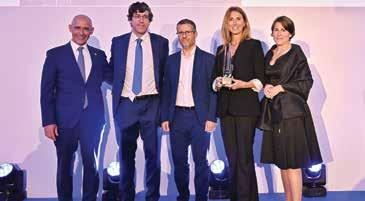







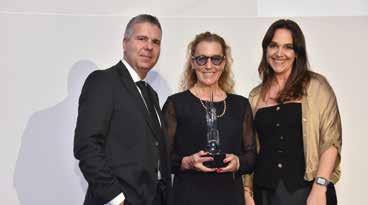





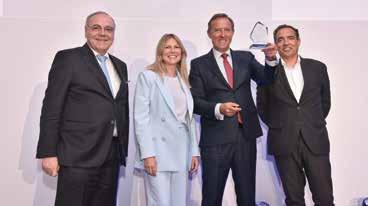
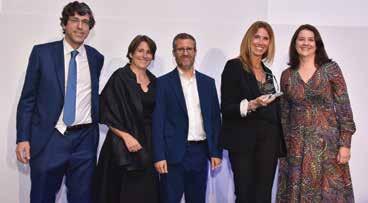
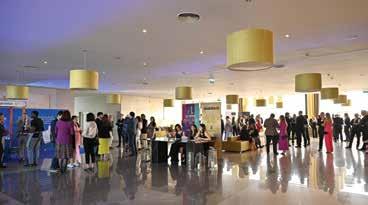
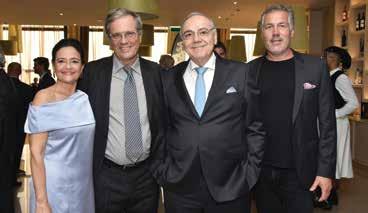






ELEVADO DESEMPENHO COMPOSIÇÃO DE MINERAIS PREMIUM UM MÁXIMO DE 10% DE CONTEÚDO DE SÍLICA CRISTALINA NOVOS DESIGNS









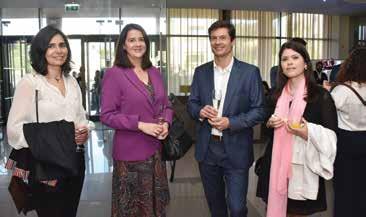
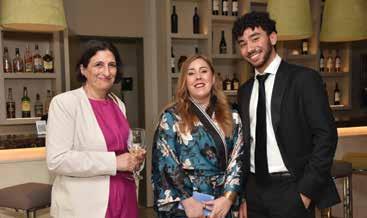

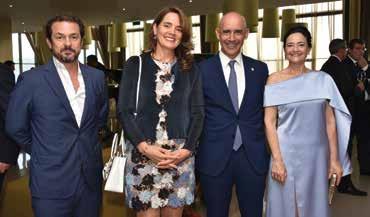

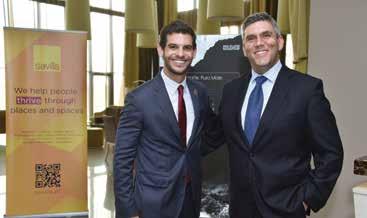

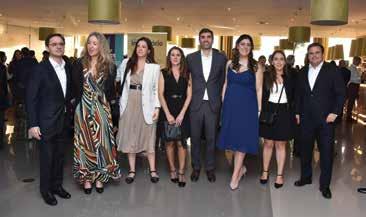





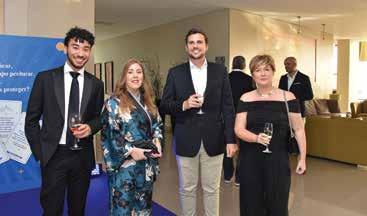

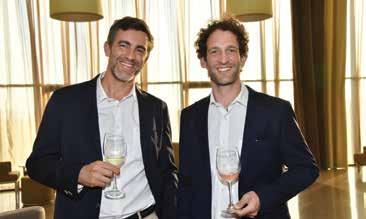







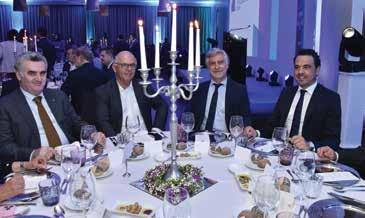


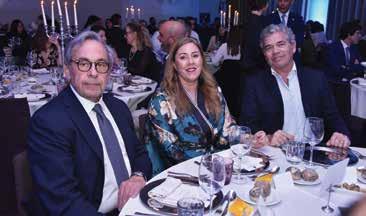







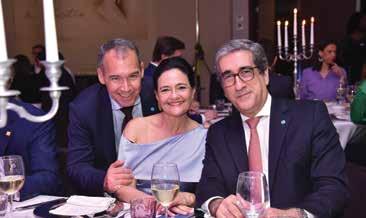











Num Algarve com um tecido urbano e natural dinâmico, sempre em movimento, erguem-se raros projectos que nos surpreendem, num misto de beleza arquitectónica, lifestyle único e serenidade para apreciar a vida. Com a chancela da Krest Real Estate surge Alvôr, um empreendimento com 24 apartamentos exclusivos em condomínio fechado com piscinas privadas, jardim e a poucos passos da praia. Mas há mais para descobrir…
In an Algarve with an urban network and natural vibrancy, always on the go, singular and surprising projects have been built blending beautiful architecture, a unique lifestyle, and a tranquillity to appreciate life. With the hallmark of Krest Real Estate arises a development with 24 exclusive apartments in a closed condominium with private pools, gardens and just a few steps from the beach. But there is more to discover...
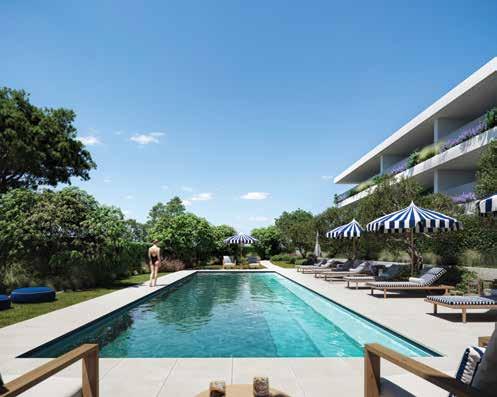
Consegue imaginar-se numa bela manhã: acordar, espreguiçar-se, abrir as cortinas, sentir o aroma das plantas aromáticas e inspirar o ar doce e salgado do Alvor e do mar algarvio? Em breve será possível com o empreendimento Alvôr da promotora imobiliária Krest Real Estate.
É no lugar das Lapas, e como o próprio nome indica, na freguesia do Alvôr, em Portimão, no Algarve, que vão ser construídos dois blocos de habitação multifamiliar e uma pequena recepção. De autoria de Costa Lima Arquitectos, o edificado é marcado por uma brancura imaculada e idealizada com o sentido de preservar e garantir uma boa integração no núcleo tradicional do casario local onde o branco marca a paisagem urbana.
Localizado a apenas 11 minutos da A22 e à mesma distância de Portimão, este lugar tranquilo para viver, visitar e investir tem fácil acesso a rigorosamente tudo.
Alvôr é o mais recente projecto lançado pela empresa Krest Real Estate, dedicada a investimentos imobiliários e com um portfólio que inclui imóveis do sector logístico, escritórios, comércio, área residencial e hotelaria. Com escritórios em Bruxelas, Lisboa e Porto, está
agora a investir na zona de Alvor, no Algarve. O empreendimento Alvôr disponibiliza áreas mais abertas no espaço público e com vistas desafogadas sobre o estuário e o mar, e áreas mais resguardadas e serenas no seu interior. Como se abrisse a sua alma ao oceano, ao mundo, e simultaneamente se recolhesse na intimidade das suas paredes.
Cada edifício oferece 12 apartamentos, seis na tipologia T2 e seis na tipologia T3, estando distribuídos uniformemente pelos três pisos (com dois apartamentos T3 e dois T2 por piso).
As tipologias dos pisos superiores contam com o acesso directo ao terraço exterior de uso privado na cobertura do edifício, sendo que oito apartamentos possuem no rooftop piscina privativa. Todo o conjunto está interligado pelo estacionamento existente na cave com 54 lugares para veículos.
Mais do que viver ou tirar férias neste empreendimento, o Alvôr promove um lifestyle saudável e de comunhão social com ginásio, yoga room, piscina com áreas para adultos e crianças, e um Club House. O espaço multiusos oferece uma sala ampla com acesso a um pátio encerrado e três balneários de apoio à piscina comum.
A Krest prevê iniciar a construção em Junho deste ano, mas as vendas terão início já no mês de Maio.

Natureza invade o casario
De pequena escala de construção, o Alvôr possui edifícios revestidos de vegetação permitindo uma integração natural com a paisagem, os espaços exteriores ajardinados e a piscina.
Os edifícios surgem implantados num jardim ligeiramente sobranceiro à rua que será caracterizado pela vegetação cuidada com relvados, árvores e plantas aromáticas variadas. Estes ajudarão a definir os percursos pedonais e os espaços de estar, garantindo simultaneamente a privacidade necessária para os apartamentos.
A pensar no meio ambiente, a promotora adoptou infra-estruturas e equipamentos que permitem poupanças de água e energia, e soluções mais sustentáveis. A título de exemplo refira-se que a rede de águas quentes deverá ser apoiada por colectores solares integrados nas coberturas, assim como prevê a instalação de sistemas de exaustão e ventilação natural e forçada dos espaços interiores.
Além das vistas ininterruptas sobre a lagoa e sobre o Oceano Atlântico, este empreendimento fica a apenas cinco minutos a pé da praia de Alvor, oferendo uma permanente suave brisa para quem deseja contemplar as ondas do mar, dar um mergulho, correr no areal,
ou simplesmente fazer castelos na areia. Concebido para famílias, o CEO Claude Kandiyoti lança o repto: “Experimente o luxo tranquilo da vida costeira em Alvôr The Breeze”, o novo projecto imobiliário exclusivo da Krest situado ao longo da serena Lagoa de Alvor, com vistas deslumbrantes sobre o mar na idílica vila de Alvor, oferecendo aos residentes um estilo de vida único”.
Can you imagine a lovely morning: waking up, stretching, opening the curtains, smelling the aroma of aromatic plants, and breathing in the sweet and salty air from the Alvor and Algarve sea. Soon you will be able to with the Alvôr development from the real estate developer Krest. And in a place called Lapas (limpets), where this shellfish is abundant as the actual name indicates, in the Algarve parish of Alvor in Portimão, two multi-family blocks and a small reception are to be built. Designed by Costa Lima Arquitectos, the buildings are characterised by a clean whiteness conceived with the idea of preserving and ensuring a neat integration within the traditional nucleus of a local house where white stands out in the urban landscape. Located just 11 minutes from the A22 and the same distance from Portimão, this peaceful place to live, visit and invest has easy access to absolutely everything.
Alvôr The Breeze é o novo projecto imobiliário exclusivo da Krest situado ao longo da serena Lagoa de Alvor, com vistas deslumbrantes sobre o mar na idílica vila de Alvor, oferecendo aos residentes um estilo de vida único.
Alvôr The Breeze is Krest’s new exclusive real estate project nestled along the serene Alvor Lagoon, boasting breathtaking sea views in the idyllic village of Alvor, offering residents a unique lifestyle”
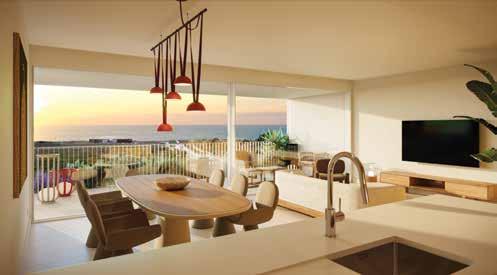
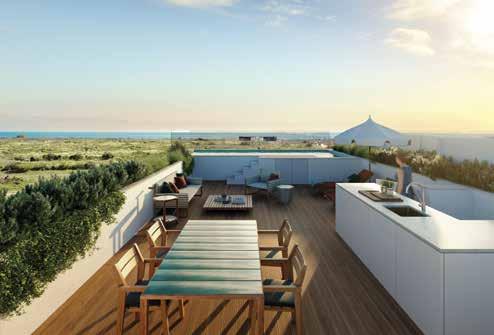
Alvôr is the latest project launched by the company Krest Real Estate, dedicated to real estate investments with a portfolio that includes properties from the logistics sector, offices, commerce, and the residential and hotels area. With offices in Brussels, Lisbon, and Porto, the promotor is now investing in the Alvor area of the Algarve.
The Alvôr development also features open public spaces with uninterrupted views over the estuary and sea and more secluded and peaceful areas within. It is as if it were opening its soul to the ocean, the world, and at the same time retreating within the intimacy of its walls.
Each building offers 12 apartments, six twobedroom and six three-bedroom apartments uniformly distributed over three floors (with two three-bedroom and two two-bedroom apartments per floor). The apartments on the upper floors feature direct access to an outdoor terrace for private use on the roof of the building, with eight apartments having a private rooftop pool. The entire ensemble is interlinked by the parking in the basement with 54 spaces for vehicles.
More than just a place to live in or spend holidays, the Alvôr fosters a healthy and community living with gym, yoga room, and swimming pool with areas for adults and children, and a club house. The multi-use space offers a spacious room with access to an enclosed patio and three washrooms to support the shared pool.
Krest plans to begin construction in June this year, but sales will start now in May.
Nature invades the houses
On a small scale of construction, the Alvôr has buildings covered in vegetation enabling a natural integration with the landscape, with outdoor garden spaces and a pool.
The buildings are inserted in a garden slightly overlooking the street that will feature welltended planted areas with lawns, trees, and various aromatic plants. These will help to define the paths and living spaces, simultaneously ensuring the privacy necessary for the apartments.
Considering the environment, the developer employed infrastructure and equipment that permit more sustainable water and energy solutions. By way of example, it should be mentioned that the hot water supply will be supported by integrated solar panels on the roofs, and natural extraction and ventilation systems are to be installed for the interior spaces.
In addition to the uninterrupted views over the lake and Atlantic Ocean, this development is just five minutes walking distance from Alvor beach, offering a constant soft breeze for those who want to enjoy the waves, take a dip in the sea, jog along the shoreline, or simply build sandcastles.
This development has been designed for families and in the words of CEO Claude Kandiyoti: “Experience the tranquil luxury of coastal living at Alvôr The Breeze”, Krest new exclusive real estate project nestled along the serene Alvor Lagoon, boasting breathtaking sea views in the idyllic village of Alvor, offering residents a unique lifestyle”.
Metro Quadrado Square Meter
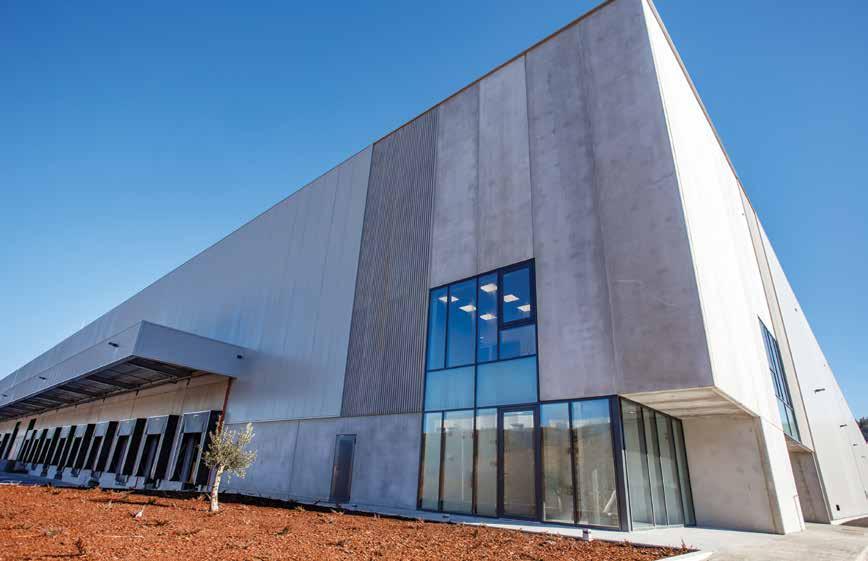
Logicor
Facing market challenges
in logistics real estate
Em 2023, verificou-se um abrandamento no sector da logística, mas a Logicor, líder no sector imobiliário logístico na Europa, conseguiu ultrapassar os desafios do contexto, através dos seus conhecimentos técnicos e rede de contactos. A empresa continua a disponibilizar espaços em localizações estratégicas de apoio aos negócios dos seus clientes.
Last year, the logistics sector experienced a slowdown. However, Logicor, a leader in logistics real estate across Europe, adeptly faced challenges using its extensive know-how and network. The company continues to provide strategic spaces to support its customers’ businesses.

Apesar dos desafios consideráveis, incluindo o crescimento na procura por activos estratégicos e a escassez de terrenos, a Logicor manteve um crescimento marcado pelo sucesso, atingindo uma taxa de 100% de ocupação para os seus activos.
A Logicor possui e gere uma área total de 20 milhões de metros quadrados (m2) em toda a Europa. Com sede em Londres e no Luxemburgo, a empresa está presente em 19 países com mais de 300 colaboradores que apoiam mais de dois mil clientes.
Fundada em 2012, a Logicor conta, em Portugal, como mais de 40 activos que representam aproximadamente 900 milhões de m2 de ABL (Área Bruta Locável). Estes activos estão localizados estrategicamente, incluindo em áreas como a Azambuja, ao longo do principal eixo rodoviário que liga a Grande Lisboa ao Grande Porto.
Enquanto líder no sector, a Logicor reconhece o impacto ambiental das actividades imobiliárias. Em 2020, a empresa apresentou o plano “Agir Responsavelmente” (“Acting Responsibly”) que estabelece ambiciosos objectivos estratégicos a atingir até 2030.
A estratégia de sustentabilidade ambiental da Logicor assenta em três pilares essenciais: Reduzir a pegada de carbono das operações através de maior eficiência energética; minimizar o carbono incorporado através da utilização e materiais pobres em carbono; e
aumentar o uso de energia renovável nos activos imobiliários.
A empresa implementou, com sucesso, estratégias para optimizar a eficiência energética, que permitiram melhorar os ratings EPC (certificação energética). De destacar o desenvolvimento do novo Centro Logístico em Ermida, Santo Tirso, que abrange mais de 30 000 m2 de área bruta locável e tem certificação BREEAM Very Good, significando que este centro logístico dá prioridade à eficiência energética, com impacto ambiental e consumo de água reduzido, estando equipado com uma central fotovoltaica de 235kW.
Em 2023, a Logicor reportou uma redução de 20% na emissão de GEE por m2, desenvolveu 25 edifícios “verdes” certificados com BREEAM Excellent, Very Good, ou equivalente, e instalou 7MWp de capacidade solar e mais de 1.5 milhões de m2 de iluminação LED. Para 2024, a Logicor prevê um aumento na procura por novos espaços para actuais e futuros clientes logísticos. O principal objectivo da Logicor é apoiar o crescimento ao mesmo tempo que facilita o fluxo comercial essencial.
Despite significant challenges, including growing demand for new strategic assets and limited land plots, Logicor successfully maintained momentum. Remarkably, they achieved a 100 percent occupancy rate for their assets.
Logicor owns and manages a total leasable

area of over 20 million square meters across Europe. Headquartered in London and Luxembourg, the company operates in 19 countries with more than 300 employees, supporting over 2,000 customers.
Founded in 2012, Logicor in Portugal boasts a portfolio of over 40 assets, covering approximately 900 million square meters GLA. These assets are strategically located, including areas like Azambuja, along the main road axis connecting Greater Lisbon and Greater Porto.
As an industry leader, Logicor recognizes the environmental impact of real estate activities. In 2020, the company unveiled its plan “Acting Responsibly,” setting ambitious sustainable goals to achieve by 2030. Logicor’s environmental sustainability strategy rests on three core pillars: Reducing operational carbon footprint through enhanced energy efficiency; minimizing
embodied carbon by using low-carbon materials; and increasing renewable energy usage in their assets.
The company has successfully implemented strategies to optimize energy efficiency, resulting in improved EPC ratings. Notably, the development of the new Logistic Park in Ermida, Santo Tirso—spanning over 30,000 square meters GLA—is BREEAM Very Good certified. It prioritizes energy efficiency, reduced environmental impact, and water conservation, featuring a 235kW PV Plant. In 2023, Logicor reported a 20% reduction in GHG emissions per square meter, developed 25 green buildings certified BREEAM Excellent, Very Good, or equivalent, and installed 7MWp of solar capacity and over 1.5 million square meters of LED lighting. Looking ahead to 2024, Logicor anticipates increased demand for new spaces from existing logistics customers and new tenants. Their goal is to support growth while facilitating essential trade flow.

A MAGAZINE IMOBILIÁRIO em parceria com a GROHE vai promover o diálogo sobre a relação entre a Indústria e a Arquitectura, integrando o Design e Inovação no sector Imobiliário.
16.05.2024
GROHE Lisbon Experience Center, Prata Riverside Village, Rua A, Lote 1, Lojas 1 e 12
16h30: Recepção dos convidados
17h00: Sessão de Boas-Vindas por Anabela Loureiro, Administradora da Magazine Imobiliário, e Bruno Borges, Leader, Commercial Portugal, LIXIL EMENA
17h10: À conversa com: Bruno Borges, Leader, Commercial Portugal, LIXIL EMENA
Margarida Ordaz Caldeira, Chair of the EMEA Board da Broadway Malyan Miguel Garcia, General Manager Garcia Garcia Tiago Belo, Chief Operating Officer da SOLYD Property Developers
18h30: Encerramento por Nelson Lage, Presidente da Adene – Agência para a Energia
18h45: Sunset Music & Chill Out


É do conhecimento geral que o mercado residencial português tem vindo a ser afectado pela falta de oferta de habitação. O preço final dos imóveis tem vindo a estabilizar, com ligeiras flutuações, com a diminuição da procura de mercado devido ao problema crónico de falta de construção, sobretudo para a classe média-baixa.
Sem surpresas, temos vindo a assistir, desde o ano passado, a uma subida das taxas de juros com impacto directo na procura. Mas apesar da venda de casas ter descido em 2023, as avaliações dos bancos têm vindo a subir, atingindo um valor recorde no mês de Fevereiro, que tem vindo a dificultar cada vez mais o acesso ao crédito habitação. O mercado de luxo encontra-se menos exposto às flutuações do mercado, dado que os clientes do segmento premium recorrem, em média, a apenas cerca de 60% do financiamento. Segundo indicadores apurados pela RE/MAX Collection, registou-se em média uma procura de três clientes diários por apartamentos de luxo, e cerca de quatro clientes visitaram por dia uma moradia Collection, assumindo ainda que nos imóveis certificados ativos, o preço médio à partida é superior ao preço médio de venda.
Já do lado da oferta, tem-se mantido a subida dos preços dos materiais e da mão-de-obra, dada a sua escassez, subidas essas que se reflectem no preço final a que as habitações são colocadas no mercado. O atraso nos licenciamentos tem vindo a dificultar o processo de construção e, por consequência, a levar à acumulação de juros durante o tempo de espera da licença, inflacionando desta
forma o valor final da obra. Na prática, a confluência destes fatores tem conduzido a uma falta de oferta de habitação e a um aumento do preço das casas no primeiro trimestre face ao ano anterior.
Dado que as construções demoram entre três a cinco anos a serem concluídas, e as poucas licenças que existem estão destinadas à construção de novos empreendimentos destinados ao segmento de luxo, é urgente simplificar a burocracia. O novo Simplex para licenciamento urbano, apesar de ainda precisar de ajustes, tem potencial para aumentar a oferta habitacional a curto e médio prazo. Contudo, é essencial clarificar e ajustar este processo para assegurar a segurança jurídica e a protecção do consumidor.
A importância da definição de uma estratégia entre os municípios e os players do sector imobiliário, que têm o conhecimento concreto de quais são as necessidades, revela-se essencial. Ao Estado é pedido que ceda terrenos das câmaras gratuitamente para a construção de casas para o segmento médio-baixo, desde que definido um preço máximo de venda e, desta forma, fosse possível construir imóveis mais baratos.
Há uma expectativa em relação a factores geopolíticos internacionais e à continuação da dinâmica positiva da economia portuguesa, apesar do desconhecimento das medidas a serem adoptadas pelo novo governo para combater a falta de habitação, antecipando uma confiança no crescimento sustentável do sector imobiliário nos próximos anos, com a tão esperada estabilização geral dos preços.
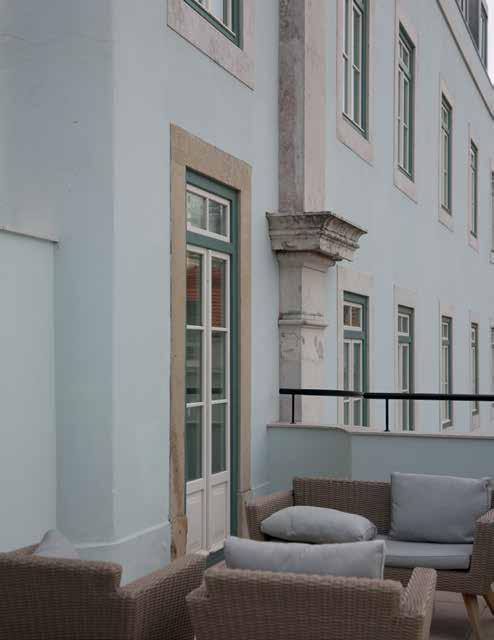
It is widely known that the Portuguese residential market has been affected by the lack of housing offer. The retail price of properties has stabilised, with slight fluctuations and a fall in market demand due to the chronic problem of a lack of new build, particularly for the lower middle class.
And it is no surprise that since last year we have seen an increase in interest rates which has had a direct impact on demand. But despite house sales falling in 2023, bank valuations of houses have gone up for mortga-
ge purposes, achieving a record in February which has made it increasingly difficult to get mortgages. The luxury market is less exposed to market fluctuations given that clients in the premium segment on average only ask for mortgages that cover around 60 of the value of the property.
According to indicators ascertained by RE/MAX Collection, one client out of every three daily is looking at luxury apartments and around four clients per day conduct viewings of properties on Collection’s books.
On the supply side there has been a continued increase in the price of building materials and labour costs because of the shortage in terms of the latter, increases that are reflected in the retail price of the homes put on the market. Hold ups in planning permissions has made building processes difficult leading to an accumulation of interest on loans while waiting for the licences, thereby inflating the final cost of property projects. In practice, these factors taken together have led to a lack of housing supply and an increase in the cost of housing in the first quarter compared to the previous year.
Given that building projects take between three to five years to be completed, and the few licences that are issued are earmarked for the luxury segment, cutting red tape is urgent.
The new Simplex for urban licensing, despite still needing some fine tuning, has the potential to increase housing supply in the medium term. However, it is essential to clarify and adjust this process to ensure legal security and consumer protection.
The importance of defining a strategy between the municipal councils and real estate sector players who know exactly what the needs are, is essential. The developers are asking the State to let local authorities to grant tracts of land free so that housing for the lower middle classes can be built providing that a maximum sale price is set and this way developers can build properties at a cheaper price.
There is an expectation in relation to international geopolitical factors and a continued positive momentum in the Portuguese economy, despite not knowing the measures that will be adopted by the new government to counter the lack of housing, confident in the expectation of the sustainable growth of the real estate sector in the years to come, together with an overall stabilisation of prices.
Green Habitat
 Sílvia Moutinho
Vice-Presidente da Direcção Nacional da Quercus
Vice-President of the Quercus National Board
Sílvia Moutinho
Vice-Presidente da Direcção Nacional da Quercus
Vice-President of the Quercus National Board
O aquecimento global é uma realidade e sem diminuirmos as emissões de gases com efeito estufa não vai parar. A construção é responsável por 40% das emissões anuais, numa avaliação mundial, sendo que a produção de materiais de construção está na origem de cerca de 15 a 20% das emissões em edifícios e 50 a 60% na construção de infra-estruturas. Sobressai aqui o cimento. A indústria produtora de cimento é a terceira maior emissora de GEE do planeta.
O conceito de construção sustentável abrange impacto no local, eficiência energética, materiais, conservação da água, qualidade do ar interno, conforto e controle dos resíduos.
É possível adaptar o sector da construção usando velhos e novos processos construtivos para reduzir emissões a fazer de construção. É exequível reutilizar materiais que são considerados desperdícios, uso como estrutura antigos contentores de transporte de mercadorias, uso de aço leve na estrutura do edifício e matérias com adobe e madeira. É sobre esta última que nos vamos debruçar.
A madeira tem a capacidade de capturar carbono. A utilização da madeira proveniente de reflorestação e usada da forma responsável. Já é largamente empregue em sistemas construtivos de habitação, hotelaria e outros, nos Estados Unidos da América, na Europa e já começa a fazer o seu caminho em Portugal. É aplicada em cerca de 90% das habitações no Norte da Europa, permitido construção em altura com edifícios como Wood Hotel, em Brumundall com 18 andares.
A madeira é um excelente isolante permitin-
do melhorar a eficiência em 50% face aos edifícios de construção tradicional, esta construção assente em processos construtivos altamente eficazes e extremamente rápidos, permite poupar recursos durante a fase de obra, além de incorporarem soluções de isolamento e de fornecimento de energia e de permitir o controlo de resíduos de obra. Esta pode ser uma resposta mais sustentável
O uso sem planeamento e o facto de implicar transporte de materiais para locais mais distantes da fonte, são factores a ter em conta em qualquer solução.
Há sempre necessidade de ajustar e procurar respostas locais para ser dar uma resposta mais eficiente à urgência de encontrar novos caminhos para reduzir emissões na indústria da construção.
Global warming is a reality and if we do not reduce greenhouse gas emissions, it will not stop. Construction is responsible for 40% of annual emissions, according to a world evaluation, with the production of construction materials responsible for around 15-20% of emissions in buildings and 50-60% in the construction of infrastructures. Cement is the worst culprit. The cement producing industry is the third major greenhouse gas producer on the planet.
The sustainable construction concept covers local impact, energy efficiency, materials, water conservation, indoor air quality, comfort, and waste control.
It is possible to adapt the construction sector using old and new building processes to reduce emissions when building. It is achie -
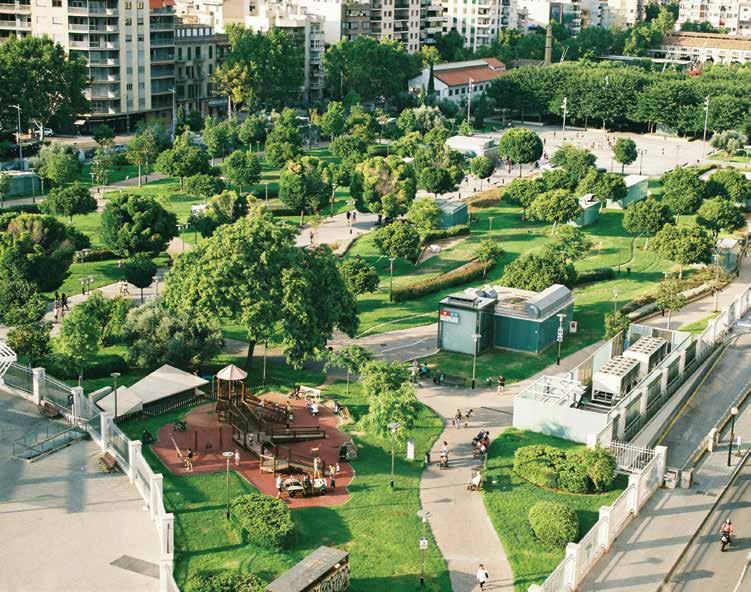
vable to reuse materials that are considered waste, using for structure old transport containers for goods, using light steel in building structure and materials with cob and wood. And it is about the latter that we will be discussing. Wood is a carbon sequester. The use of wood from reforestation and used in a responsible way. It is already widely used in housing and hotel building systems and others in the United States of America, in Europe, and has begun to make inroads in Portugal. It is applied in around 90% of housing in Northern Europe, enabling the construction of high-rise buildings such as the 18-storey Wood Hotel in Brumundall, Norway. Wood is an excellent insulator permitting
improved efficiency of 50% compared to traditionally constructed buildings. This construction is based on highly efficient and extremely fast building processes enabling resource savings during the building phase, in addition to incorporating insulation, and energy supply and enabling building waste control. This can be a more sustainable solution.
Use without planning is a factor that involves transporting materials to places far from source are factors to consider in any solution. There is always the need to adjust and seek local solutions to more efficiently meet the urgency of finding new paths to reduce emissions in the construction industry.

“Tradição
o que era”
“Tradition is still what it was”
São mais de uma centena as lojas históricas do Porto, onde se preserva o comércio tradicional, mas também o valor patrimonial e cultural da cidade.
There are over 100 historic Porto stores where traditional shopping has been preserved, but also the city’s cultural and heritage value.

Dar um passeio pela Baixa do Porto e aproveitar para entrar em algumas das mais emblemáticas lojas históricas, localizadas em ruas como o Bonjardim, Fernandes Tomás, Sá da Bandeira ou Clérigos - e conseguir fazê-lo num dos dias soalheiros que brindaram a cidade neste Inverno –, ajuda a perceber porque é que a Invicta se tornou uma referência internacional em termos turísticos. E, sem dúvida, a certeza de que a preservação das lojas históricas, para o qual muito contribuiu o programa Porto de Tradição, lançado em 2018 pela autarquia portuense, foi um dos factores que ajudou a atingir esse galardão.
A opinião é partilhada pelos responsáveis de algumas lojas históricas visitadas. É o caso de uma das mais conhecidas, a Pérola do Bolhão, com uma localização ímpar – próxima do Mercado do Bolhão e da Rua de Santa Catarina – e, por isso, uma das mais visitadas, tanto por turistas, como por nacionais. Fundada em 1917, pelo pai do actual proprietário António Reis, A Pérola do Bolhão atrai turistas que compram sobretudo “os produtos que podem levar na viagem de regresso, conservas, queijos, presunto e garrafas em miniatura de Vinho do Porto”, conta. Embora conhecida pela beleza da fachada de Arte Nova, que atrai, só por si, os visitantes, António Reis destaca a importância de ter “boas montras, que sejam apelativas”. Por isso, a mercearia tradicional “tem investido
na modernização da loja, sobretudo em máquinas e na rede de frio através dos apoios do programa Porto de Tradição”, acrescenta o proprietário.
Bem próxima, mas do outro lado da rua Formosa, fica a Mercearia do Bolhão, que existe desde 1880, sendo, por isso, uma das mais antigas do género do Porto. Especializada em bacalhau, e outros produtos de mercearia, foi visível ver a azáfama dos funcionários para atender os pedidos de clientes, mas também de muitos curiosos, numa tarde do mês de Janeiro.
São diversificados os ramos de actividade das lojas históricas no Porto. É o caso da Casa Hortícola, aberta desde 1921, que manteve sempre a venda especializada de sementes, bolbos e plantas, entre outros, que iniciou a sua actividade no Mercado do Bolhão, na Rua de Alexandre Braga, e agora está instalada na loja 1 (antigo Torreão), situado na esquina da Rua Sá da Bandeira e da Rua Formosa.
Caminhando em direcção à Rua do Bonjardim, próximo da Trindade, encontramos outra loja emblemática, O Pretinho do Japão, uma histórica mercearia, fundado no ano de 1947 que vende uma ampla gama de produtos gourmet, mas onde o destaque vai para o bacalhau e para o café moído na hora, numa panóplia de mais de 800 produtos expostos.
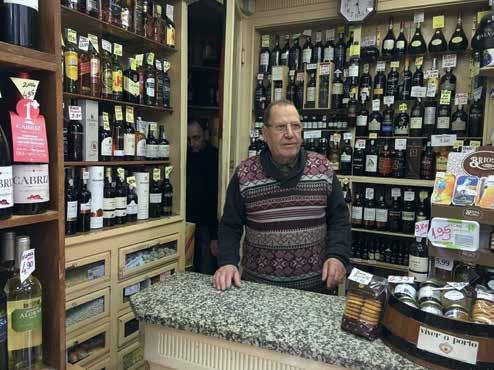
Helena Machado, colaboradora da loja, destaca a importância do Porto de Tradição, sendo “o apoio que precisávamos para melhorar a loja”, diz. Sendo Janeiro, um dos meses mais fracos nas vendas, depois do período das festas de Natal e do Ano Novo, vai dizendo que “a quebra se sente mais numa altura em que ainda há poucos turistas”. Localizada ao lado, a mercearia Feira do Bacalhau, fundada em 1925, e curiosamente uma loja tradicional que não aderiu ao programa Porto de Tradição. Porque, diz Joaquim Fernando, proprietário, “a clientela que é bem atendida volta, é a nossa melhor publicidade”.
Ainda na Rua Bonjardim encontramos a Casa Januário, que resulta da concretização do sonho de um jovem empreendedor vindo de uma família do Fundão, que se estabeleceu no Porto em 1926, Januário Gil Mendes Ferreira. O Porto de Tradição “valorizou muito a loja”, afirmam em uníssono as várias colaboradoras que com grande azáfama fazem a reposição dos vários produtos de mercearia fina.
“Não vivemos do turismo”, mas “é um bom suporte”, afirma uma das funcionárias. Enquanto outra destaca, que “desde a abertura do Mercado do Bolhão a afluência dos turistas reduziu-se”. Contudo, a aposta da loja passa, por isso, “por fazer parcerias e apostar na degustação de produtos”, referem.
Criado para salvaguardar o comércio local e tradicional, mas também o valor patrimonial, cultural e afectivo das suas lojas históricas, o Porto de Tradição viu, em cerca de quatro anos, 106 e mais quatro instituições aderirem a esta iniciativa. As últimas placas Porto de Tradição foram entregues no final do ano passado ao Café Velasquez, Restaurante Peza Arroz e ao Restaurante A Regaleira.
Taking a stroll around Porto’s downtown baixa district, and taking the opportunity of entering some of the more emblematic historic shops located on streets such as Bonjardim, Fernandes Tomás, Sá da Bandeira, or Clérigos - and to be able to do so on one of the sunny days that greet the city this winter -, helps you to understand why Porto has become an international reference in tourism terms. And, without a doubt, the certainty that the preservation of historic shops, which have contributed so much to the Porto of Tradition programme launched by the Porto city council in 2018, was one of the factors that helped attain this distinction. The opinion is shared by the proprietors of some of the historic shops visited. Such is the case of one of the most famous, the Pérola do Bolhão (The Pearl of Bolhão) with an unrivalled location close to the Mercado do Bolhão market and Rua de Santa Catarina, which is why it is one of the most visited,

both by tourists and nationals. Founded in 1917 by the grandfather of the current owner, António Reis, the Pérola do Bolhão attracts tourists that mostly buy “products that they can take on their return trip; preserves, cheeses, cured hams and Port wine miniatures, among them. Although known for the beauty of its Art Nouveau façade that attracts visitors, António Reis highlights the importance of having “good shop windows” that are appealing. Which is why the traditional grocers has “invested in modernising the shop, particularly in equipment and cold cabinets through the aid programmes Porto of Tradition,” adds the owner.
Close by, but on the other side of Rua Formosa, is the Market of Bolhão that has existed since 1880, which makes it one of the oldest stores of its type in Porto. Specialising in dried codfish and other groceries, the hustle and bustle of the staff attending to the customers’ requests was evident, but also the many curious onlookers on that January afternoon.
The type of activities engaged by Porto’s historic stores is diverse. Such a case is the Casa Hortícola, open since 1921 that has always retained the specialised sale of seeds, bulbs, and plants, among other things. It began trading in the Bolhão market on Rua de
Alexandre Braga and is now installed in Store 1 (the former Torreão - ‘The Turret’) located on the corner of Rua Sá da Bandeira and Rua Formosa.
Strolling in the direction of Rua do Bonjardim, close to Trindade, you come across another emblematic store, O Pretinho do Japão, a historic grocers’ founded in 1947 that sells a wide range of gourmet products, but which is famous for its dried codfish and coffee that is ground hourly, and has a bewildering array of 800 products on display.
Helena Machado, a staff member, highlights the importance of Porto of Tradition for the “support we needed to improve the store,” she says. Being January, one the slowest months for sales after the festive periods of Christmas and New Year, she tells us that the “drop off in customers is felt at a time when there are few tourists.”
Located next door, the Feira do Bacalhau grocers founded in 1925, is curiously a store that did not sign up for the Porto of Tradition programme. Because, says owner Joaquim Fernandes, “customers that are well served come back and that’s our best publicity.”
Also, on Rua Bonjardim we find the Casa Januário, which resulted from achieving the dream of a young entrepreneur who came from a Fundão family that set up in Porto in 1926, Januário Gil Mendes Ferreira. Porto of Tradition “really valued the store” the various staff members tell us who are busy re -
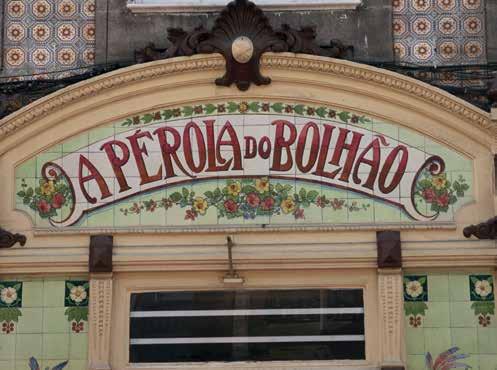
placing the various products in this fine delicatessen.
“We don’t live from tourism,” but “it helps a lot,” say the staff. And another says that “since the reopening of the Mercado do Bolhão market, the flow of tourists has gone down.” However, the shop has gone in for “making partnerships” and focusing on sampling the products,” they say.

Created to safeguard traditional local trade, but also value the cultural heritage and affection people have for these historic stores, Porto of Tradition has seen over 106 stores, and four institutions sign up to this programme. The latest Porto of Tradition signs were awarded at the end of last year to Café Velasquez, Restaurant Peza Arroz and Restaurant A Regaleira.


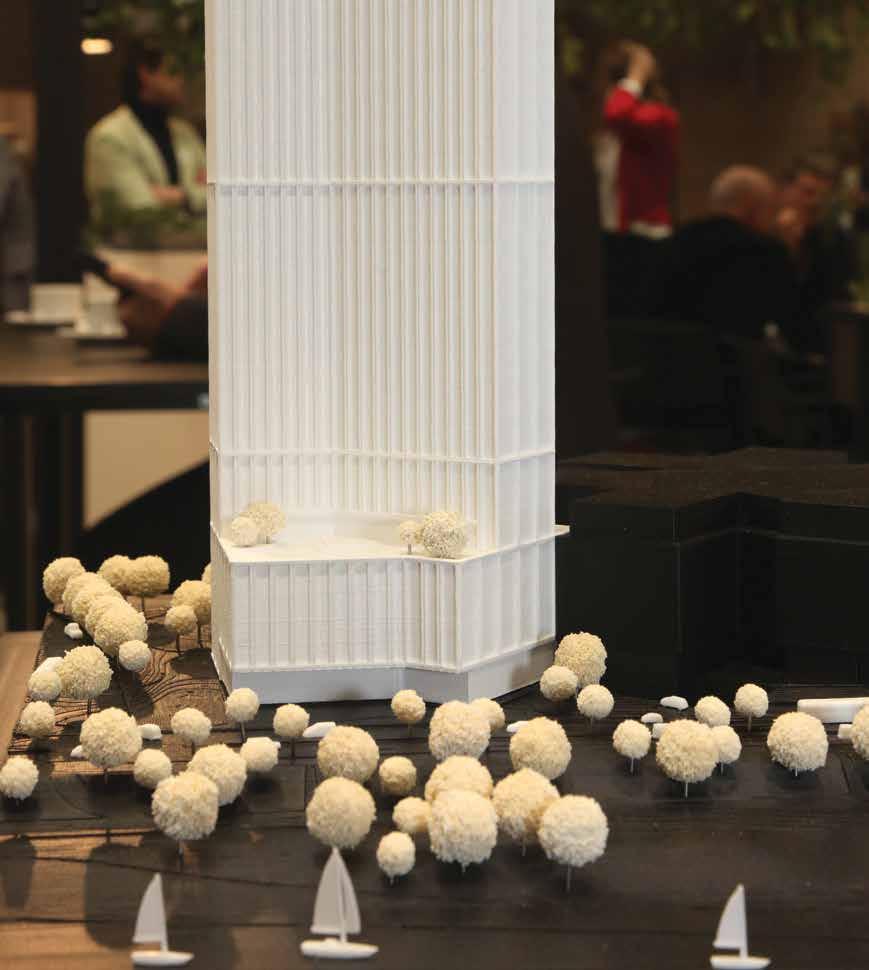
MIPIM
Lisboa e Porto estiveram em grande na 34ª edição do MIPIM, com comitivas e empreendimentos cada vez mais representativos do melhor que se faz no nosso País. Esta, que é uma das maiores feiras europeias dedicadas ao imobiliário, recebeu 340 stands, cerca de 20.000 representantes e mais de 6.500 investidores de 90 países.
Lisbon and Porto were in force at the 34th edition of MIPIM, with delegations and developments that are increasingly more representative of the best that Portugal can do. MIPIM is one of the largest European fairs dedicated to real estate hosting 340 stands, around 20,000 representatives, and more than 6,500 investors from 90 countries.
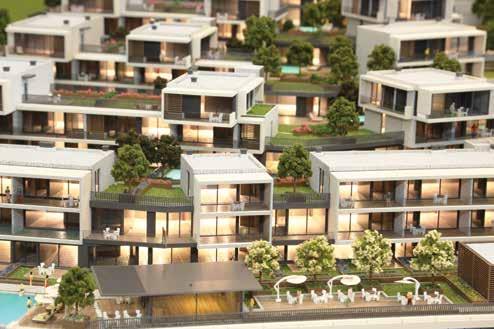
De uma forma geral, sentimos um ambiente de arrefecimento no MIPIM 2024. Não obstante, investidores, líderes políticos e a comunidade imobiliária mundial estiveram reunidos em Cannes, para, em conjunto, encontrar soluções para os desafios do ambiente construído, nomeadamente das ciências da vida, habitação e energias renováveis.
Pastéis de nata e negócios
Sim, não faltaram pastéis de Belém para adoçar a boca dos investidores, curiosos e visitantes que passaram pelo stand da LisboaInvest. Entidade que, saliente-se, está de parabéns! O espaço expositivo esteve mais green e acolhedor, levou mais entidades, empresas e projectos ao Palais des Festivals e esteve, desde o primeiro dia da feira, ao rubro. Foi, sem sombra de dúvida, “o” ponto de encontro de quem quer ver e ser visto.
A Nhood não é uma empresa estreante, por isso questionámos Carlos David, Development Director e Projectos Retrofit & Repurpose para Portugal e Estrangeiro, sobre a importância de regressar a um evento desta natureza e cariz internacional. Ao que nos disse que representa “uma oportunidade de networking e angariação de novos clientes, enquanto permite “medir o pulso ao mercado”, nomeadamente no que ao investimento diz respeito.”
Salienta, e concordamos com Carlos David, que “Portugal conta, tradicionalmente, com uma escala e pipeline reduzidos neste grande evento, mas é de sublinhar o grande interes-
se que desperta e a confiança que os investidores depositam nos nossos projectos. As novas soluções de habitação e hospitalidade têm estado no topo da lista de interesses.”
A par desta empresa estiveram patentes a AVENUE, B. Prime, Eastbanc, Krest Real Estate Investments, VIZTA, Contacto Atlântico, Capinha Lopes Consulting, CORE, VIC, Atenor, Wanted Real Estate, Portugal Solutions, CCA Advogados, entre outras.
Houve vários projectos surpreendentes. Destacamos o Entrecampos, da Fidelidade Properties, cujas obras já decorrem a bom ritmo e cujo vídeo exibido mostrou a forma final deste mega projecto. E também o WAYA Hotel Sintra.
Tiago Câmera, partner da Waya Hotels, à procura de investidores, apresentou-nos este aparthotel de luxo localizado na proximidade da praia das Maçãs, em Sintra. É constituído por dois edifícios que funcionam como aparthotel com 10 apartamentos, entre estúdios e apartamentos T1, e um edifício no meio que oferece áreas sociais e de lazer, incluindo eventos culturais e corporativos, academia, health club, piscinas externa e coberta e estacionamento.
Há sempre, pois, algo português e inovador, para se contemplar e descobrir no MIPIM.
Oportunidades e debates
Joana Almeida, vereadora do Urbanismo da Câmara Municipal de Lisboa, e Filipa Roseta, vereadora da Habitação e Desenvolvimento Local da Câmara Municipal de Lisboa, mos-

traram no stand da LisboaInvest a estratégia que está a ser implementada, nomeadamente em termos de habitação, assim como as oportunidades de investimento que a capital portuguesa tem para oferecer.
Vila Franca de Xira e Almada apresentaram igualmente o que de melhor se está a fazer nestas regiões e as potencialidades que se podem abrir nos seus horizontes. Aliás, um dos projectos em destaque da autarquia de Vila Franca de Xira foi a Quinta dos Carvalhos, entre Alhandra e Arruda dos Vinhos, de autoria do gabinete Traçado Regulador, que vai contar com 171 moradias, 11 lotes de habitação colectiva e 1.320 metros quadrados (m2) de comércio e serviços. Entre as presenças portuguesas, a JLL Portugal avançou que teve em 2024 a maior presença de sempre neste evento com sete representantes portugueses de áreas de negócio como Residencial, Capital Markets, Avaliações e Markets. Em declarações à Magazine Imobiliário, Gonçalo Santos, Head of Capital Markets, destacou a Conferência que juntou os municípios de Lisboa, Porto e Almada numa apresentação dos programas municipais de incentivo à produção de mais oferta residencial no segmento de Renda Acessível. Na sua opinião, “estes programas, ao contrário de tentativas anteriores, alinham-se muito mais com as expectativas dos investidores e o sentimento geral no fim deste evento foi de muito entusiasmo quanto ao sucesso destas iniciativas, o que se traduzirá em mais oferta habitacional, para um segmento ca -
renciado da população.”
Aliás, a temática da habitação, ou a falta dela e os elevados preços, foi uma constante em todos os corredores do MIPIM, a revelar que é uma questão preocupante e global.
Ventos do Norte
Muito embora a informação estivesse limitada a alguns órgãos de informação, pelo que a Magazine Imobiliário pode apurar, os municípios de Gaia, Porto e Matosinhos regressaram em força ao MIPIM com a meta clara de atrair mais investimento estrangeiro, para sermos mais precisos: investimentos na ordem dos 10 mil milhões de euros até 2030, onde o maior alvo será a habitação.
Uma das empresas com muita actividade no stand Greater Porto foi a KEO International Consultants, consultora especializada na prestação de serviços de planeamento, arquitectura, engenharia, sustentabilidade e gerenciamento de projectos e construção. Falámos com Margarida Tavares, project manager, que nos revelou que, depois do seu primeiro escritório no Porto, em 2020, vão inaugurar dentro em breve oficialmente o seu escritório no Parque das Nações, em Lisboa. No ano passado a Magazine Imobiliário teve a oportunidade de conhecer a REVITO – Real Estate Vision for Tomorrow que nos surpreendeu pela qualidade dos seus projectos. Este ano regressaram e com novos desenvolvimentos, onde se destacou o Atlantic Villas com 12 moradias à beira mar e à beira rio, em Gaia.
Numa parceria estabelecida entre a Câmara Municipal de Bratislava (Eslováquia) e as empresas SPAK-EKO e EcoButt, a empresa de gestão de resíduos da cidade de Bratislava - Odvoz a Likvidácia Odpadu (OLO) anunciou que vai reciclar os filtros dos cigarros após a sua utilização para fins construtivos.
Para o efeito, vai colocar contentores para beatas de cigarros em eventos públicos, já a partir de 2024. Após a recolha pontas de cigarro, segue-se o processo de transformação e reutilização destes resíduos numa mistura que permite criar asfalto para estradas. Em Žiar nad Hronom, no Centro da Eslováquia, a EcoButt construiu aquela que é considerada ser a primeira estrada do mundo feita a partir de uma liga com base em beatas de cigarros.
In a partnership established between the Bratislava City Council (Slovakia) and the companies SPAK-EKO and EcoButt, a Bratislava city waste management company - Odvoz a Likvidácia Odpadu (OLO) announced that it would recycle the filters of cigarettes after their use for constructive ends. To this end, it will place containers for cigarette butts at public events from 2024. After collecting the cigarette butts there follows a process of transforming and reusing this waste in a mixture that can be used to create asphalt for roads.
In Žiar nad Hronom, in the centre of Slovakia, EcoButt built what is considered to be the first road in the world made from an alloy based on cigarette butts.
Entre as empresas patentes no espaço nortenho estiveram a Cilviria, Garcia Garcia - Design & Build, Emerge - Mota-Engil Real Estate Developers, IDS Grupo, Geo Investimentos, VPM Real Estate, Lionesa Business Hub, entre outras.
A proximidade com o stand de Barcelona e até de Madrid faz-nos pensar, no entanto, num afastamento nacional e, cada vez mais, numa globalização Ibérica do Greater Porto. A paredes meias encontrava-se também o Stand do Fundão. Falámos com o arquitecto e Head of Innovation Area da InvestFundão, Toni Barreiros, que nos revelou que a terceira participação foi muito profícua em intenções de investimento, nomeadamente em habitação. Com mais de 70 nacionalidades a viver na região e a continuar a atrair talento, sobretudo tecnológico, até o Fundão está a sentir a pressão da falta de casas.
Portugal continua a atrair investimento
Apesar do esmorecimento do MIPIM 2024, fazemos um balanço positivo de um dos maiores pontos de encontro dos players do imobiliário a nível europeu.
Uma ideia partilhada por Gonçalo Santos que considerou que “os players de mercado que marcaram presença estavam efectivamente interessados em encontrar oportunidades alinhadas com as suas estratégias e em geografias resilientes, como é o caso de Portugal.” Rematando dizendo que “o nosso País
continua a atrair muita atenção da comunidade internacional de investimento, maioritariamente pelo desequilíbrio entre oferta e procura, verificado em vários sectores do nosso mercado imobiliário, com especial enfase para a Habitação.”
Exposto isto, marque já na sua agenda: a próxima edição do MIPIM acontece entre os dias 10 e 14 de Março de 2025.
Overall, we felt that the atmosphere was subdued at MIPIM 2024. Nevertheless, investors, political leaders, and world real estate community gathered at Cannes to jointly find solutions to the challenges of the built environment, namely life sciences, housing, and renewable energies.
Indeed, there was no shortage of Portuguese custard tarts to sweeten the mouths of investors, the curious and visitors who dropped by at the LisboaInvest stand. An entity which, it should be mentioned, is to be congratulated. The exhibition space, which was greener and welcoming, attracted more entities, companies and projects to the Palais des Festivals and was, from the first day of the fair, thronging with people. It was, without a shadow of a doubt, “THE” meeting point for those who want to see and be seen.
Nhood as a company is no stranger to MIPIM, which is why we spoke to Carlos David, Direc-
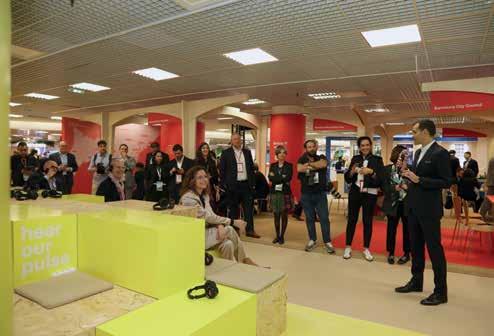
tor of Development and Retrofit and Repurpose for Portugal and Overseas, about the importance of returning to an event of this nature and international stature. To which he told us that it represents “an opportunity for networking and bringing in more clients, while it is also useful for ‘testing the mood of the market’ particularly where investment is concerned.”
He emphasises- and we agree with Carlos David - that “Portugal traditionally must rely on a reduced scale and pipelines at this big event, but it is worth pointing out the great interest that it attracts and the confidence that investors place in our projects. The new housing and hospitality solutions have been at the top of the list of interests.”
Also present, as well as this company, were AVENUE, B.Prime, Eastbanc, Krest Real Estate Investments, VIZTA, Contacto Atlântico, Capinha Lopes Consulting, CORE, Atenor, VIC, Wanted Real Estate, Portugal Solutions, CCA Advogados, among others.
There were several surprising projects. We highlight Entrecampos from Fidelidade Properties, whose projects are proceeding at a fair rate and whose video showed what the mega project would eventually look like. And, the WAYA Hotel Sintra.
Tiago Câmera, partner of Waya Hotels, looking for investors, presented this luxury aparthotel near to the Praia das Maçãs beach in Sintra to us. It comprises two buildings that operate as an aparthotel with 10 apartments, including studios and T1 apartments, and a building in the middle that offers social and leisure areas, including for cultural, corporate, and academic events, a health club, indoor and outdoor pools, and parking. Indeed, there is always something innovative and Portuguese to discover and contemplate at MIPIM.
Joana Almeida, council officer for Lisbon City Council’s Urban Planning Department, and Filipa Roseta, Lisbon City Council’s officer for Housing and Development showed at the LisboaInvest stand the strategy that is being implemented, namely in terms of housing, as well as the investment opportunities that the Portuguese capital has to offer.
Vila Franca de Xira and Almada also presented the best projects it is doing in these regions and the potential that can broaden our horizons.
Moreover, one of the highlighted projects
from the Vila Franca de Xira local authority was Quinta dos Carvalhos, between Alhandra and Arruda dos Vinhos, designed by the studio Traçado Regulador, and will feature 171 town houses, 11 collective housing lots, and 1,320 square metres (m2) of commerce and services.
From among the Portuguese presence, JLL Portugal revealed that it had the largest presence ever at this 2024 event with seven Portuguese representatives from business areas such as Residential, Capital Markets, Evaluations and Markets. In statements to Magazine Imobiliário, Gonçalo Santos, Head of Capital Markets, highlighted the conference that joined the municipalities of Lisbon, Porto, and Almada in a presentation of municipal programmes to encourage the building of more residential supply in the Affordable Rental segment.
In his opinion, “these programmes, contrary to previous attempts, align a lot more with the expectation of investors and the general feeling at the end of this event was one of enthusiasm as to the success of these initiatives, which will translate into more housing offer for a needy segment of the population.”
Furthermore, the topic of housing, or the lack of it, and the soaring prices, was a constant in all the corridors of MIPIM, is revealing a worrying and global issue.
Although information was very limited to
some media organisations, from what Magazine Imobiliário was able to find out, the municipalities of Gaia, Porto and Matosinhos returned in force to MIPIM with a clear target to attract more overseas investment, to be more precise: investment in the order of 10 thousand millions euros to 2030, where the main target will be housing.
One company that had a lot going on at the Greater Porto stand was KEO International Consultants, a consultancy specialised in planning services provisions, architecture, engineering, sustainability, and construction project management. We spoke to Margarida Tavares, who told us that after its first office in Porto in 2020, it will shortly officially open its office in Parque das Nações, Lisbon.
Last year, Magazine Imobiliário had the opportunity to get to know REVITO - Real Estate Vision for Tomorrow, which surprised us by the quality of its projects. This year they returned with new developments from which Atlantic Villas stood out with 12 town houses by the sea and river at Gaia.
Among the companies at the Porto stand were Civilria, Garcia Garcia - Design & Build, Emerge - Mota-Engil Real Estate Developers, IDS Group, Geo Investimentos, VPM Real Estate, Lionesa Business Hub, among others.
Being near to the Barcelona stand and even Madrid made us think, however, about Portugal being increasingly sidelined in an Iberian globalised of Greater Porto.
Next door was the Fundão stand. We spoke
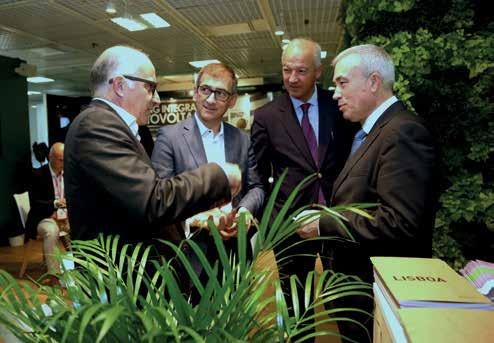
with the architect and Head of Innovation Area at InvestFundão, Toni Barreiros, told us that the third participation was replete with investment intentions, namely in housing. With more than 70 nationalities living in the region and continuing to attract talent, particularly technology, and even Fundão is feeling the pressure from the lack of houses.
Despite the torpor of MIPIM 2024, the balance was positive for one of the largest meeting points for real estate players at a European level.
It is an idea shared by Gonçalo Santos who considered that the “market players that were present were actually interested in seeking out opportunities aligned with their strategies and in resilient geographies, as is the case with Portugal.” And reinforced this by saying “our country continues to attract a lot of attention from the international investment community, mostly from the imbalance between supply and demand, seen in various sectors of our real estate market, particularly Housing.”
So now you know, pencil in the dates of the next edition of MIPIM in your diary, which takes place between 10 to 14 March, 2025.
MIPIM é uma oportunidade de networking e angariação de novos clientes, enquanto permite “medir o pulso ao mercado”, nomeadamente no que ao investimento diz respeito.
MIPIM is an opportunity for networking and bringing in more clients, while it is also useful for ‘testing the mood of the market’ particularly where investment is concerned.”

Consultoria de Comunicação e Relações Públicas
Reputação e Imagem institucional
Estratégia Mediática
Assessoria de Imprensa
Serviço de Clipping
Dossier de Imprensa
Press Kits
Comunicação de Crise
Formação e Media
Trainning
Contacto com os Órgãos de
Comunicação
Social

Comunicação Interna
Publicações Empresariais
Design e Imagem de marca
Gestão de Influencers


United Kingdom
 Managing Director Europa Capital Partners / Mitsubishi Estate Co.
Managing Director Europa Capital Partners / Mitsubishi Estate Co.
As recentes eleições em Portugal, trouxeram alguma esperança aos agentes económicos, em particular ao nosso sector. Ninguém pode negar que, em muitas áreas, o mercado em Portugal encontra-se altamente distorcido. Trago algumas ideias e sugestões para este novo Governo para diminuir ou eliminar essas distorções, trazer crescimento económico e melhorar a vida dos cidadãos.
Regulamentar o “build-to-rent”
Muito embora exista falta de habitações à venda nas grandes cidades, há uma lacuna ainda maior de habitações para arrendamento. Nos mercados de capitais internacionais, existem fundos e operadores 100% dedicados a esta estratégia de construir imóveis residenciais, normalmente edifícios de apartamentos, para somente arrendar. Os investidores gostam desta estratégia dada a diversificação dos cashflows e por ser um serviço de necessidade básica.
Um sector de “build-to-rent”, bem regulamentado, traria um maná de capital que, em pouco tempo, aumentaria a oferta deste tipo de imóveis no mercado.
O alojamento local foi um dos sectores mais importantes na recuperação do País da bancarrota a partir de 2011. Além do investimento directo que trouxe ao parque de imóveis, principalmente em Lisboa e Porto, trouxe também liquidez ao mercado e a valorização das casas como efeito colateral. Não só renovou muito do parque habitacional das cidades, como, com um pouco de apreciação e renovada procura por estes imóveis, resolveu o problema dos maus créditos dos bancos. Criou também
muitos empregos directos e indirectos quando o País mais precisava.
Muitos dos investidores mais pequenos, eu incluído, investiram em imóveis para alojamento local, para verem depois a regulamentação em catadupa limitar fortemente a actividade. Pior só a fiscalidade que retirou a rentabilidade necessária para o sector prosperar. O anterior Governo optou por prejudicar os donos de imóveis em alojamento local, muitos dos quais têm como o seu único emprego e fonte de rendimento precisamente o imóvel que gerem, com a promessa de que traria casas ao mercado para arrendamento de longo prazo. É dúbio que isso tenha acontecido em alguma escala. Não foram só os efeitos directos no sector imobiliário que esta nova forma de fazer férias trouxe ao País, foi também toda a dinamização do sector turístico e a projecção do próprio País. O mercado foi muito criativo e desenvolveu uma oferta muito apelativa aos turistas em diferentes segmentos de preço e em zonas anteriormente desertas de investimento turístico.
Deixem este sector desenvolver-se de novo, sem as amarras regulamentares e fiscais!
Novos conceitos residenciais
Co-living, micro-apartamentos, “homes of multiple occupation”, “extended stay”, e outros, são conceitos existentes em diferentes mercados e que servem os mais variados propósitos. O co-living faz sentido para estudantes e jovens profissionais, muitas vezes deslocados das suas cidades ou países de origem. Têm acesso a uma habitação de relativo baixo custo, normalmente de construção nova, com todos os serviços incluídos, integrados numa comunidade de jovens em situação similar.
Os micro-apartamentos, embora seja um conceito pouco apelativo à primeira vista, serve um propósito parecido com o co-living, proporcionando habitação a mais baixo custo. O “extended stay”, por exemplo, é um conceito que já existe na regulamentação portuguesa mas mal desenhado, o que pode justificar o pouco investimento que tem atraído. Neste caso, um profissional que esteja deslocado da sua cidade ou país por seis meses ou um ano, tem muita dificuldade em fazer um contrato de arrendamento tradicional, já para não falar nas burocracias de todos os serviços que tem que contratar.
Nem toda a solução da habitação passa por construir mais casas, mas é necessário adequar a tipologia da oferta com a procura e as reais necessidades das pessoas nas suas diferentes fases de vida.
O anterior Governo flexibilizou, e bem, a alteração de uso de certos imóveis. É preciso aprofundar esta mudança para que os próprios agentes económicos criem a oferta nos mercados onde são precisos e melhorar o aproveitamento económico do stock de activos, assim como o sector da construção.
É urgente reduzir a fiscalidade do sector. De acordo com os cálculos de vários operadores e promotores no sector residencial, mais de 40% do custo de uma casa são impostos. Não se pode ao mesmo tempo querer que as pessoas tenham acesso a habitação acessível, mas depois extrair tamanha receita fiscal da actividade. E não é só nos consumidores finais, tem que ser nas fases intermédias. A fiscalidade muitas vezes impede negócios de acontecerem dado o alto custo transacional do imobiliário.
Desde do início do programa de vistos gold, iniciado em 2012, terão sido vendidas menos 15,000 casas aos seus destinatários. Estas casas tinham a obrigação de serem transaccionadas a um valor acima dos 500 mil euros (mais tarde 350 mil euros nas regiões do interior e nas ilhas), e não eram casas de nível baixo ou médio. Num parque de milhões de casas em Portugal, não é sério culpar os vistos gold pela falta de habitação no País. Além de se tratar de estrangeiros com capital para inves-
tir, normalmente com bastante mobilidade, muitas vezes estas casas até retornavam para o mercado de arrendamento. É uma pena não termos esta ferramenta para atrair este tipo de indivíduos e as suas famílias.
Todas estas inovações e flexibilidade não servem de nada se, a nível local, as autarquias não acompanharem e mantiverem, em muitos casos, os seus processos altamente burocráticos. O Governo central precisa de impôr aos regimes de licenciamento das diferentes autarquias, prazos certos, responsabilidade e transparência aos municípios. O entravamento dos licenciamentos promove a corrupção e um aumento de custos no produto final. Tempo é dinheiro.
Desejo a este Governo muito sucesso nesta área. Não é só o sector que precisa, é o País inteiro!
The recent elections in Portugal have brought some hope to the economic agents, especially in our sector. No one can deny that, in many areas, the market in Portugal is highly distorted. I bring some ideas and suggestions for this new government to reduce or eliminate these distortions, bring economic growth, and improve the lives of the citizens.
Regulate “build-to-rent”
Although there is a lack of housing for sale in the big cities, there is an even bigger gap of housing for rent. The international capital markets, are awash with capital from funds and operators 100% dedicated to this strategy of building residential properties, usually apartment buildings, for rent. Investors like this strategy because of the diversification of cash flows and because it is a service of basic need. A well-regulated “build-to-rent” sector would bring a windfall of capital that, in a short time, would increase the supply of this type of property to the market.
Holiday rental properties was one of the most important activities to help the country’s recovery from bankruptcy from 2011. Beside the direct investment that it brought to the property stock, mainly in Lisbon and Porto, it also brought liquidity to the market and the appreciation of the houses as a collateral effect. Not only did it renovate much of the housing stock of the cities, but, with a little price appreciation
Abroad and renewed demand for these properties, it solved the problem of many of the bad loans the banks held on their balance sheets. It also created many direct and indirect jobs when the country needed it most.
Many smaller investors, myself included, invested in local accommodation properties only to experience a cascade of regulation with the objective to severely limit the activity. Worse yet was the increased taxation that killed the sector’s profitability. The previous government chose to harm the owners of holiday rental properties, many of whom have as their only job and source of income, precisely the property they manage, with the promise that it would bring houses to the market for long-term rental. It is dubious that this has happened on any scale.
It was not only the direct effects on the real estate sector that this new way of holidaying brought to the country, it was also the invigoration of the tourism sector and the projection of the country itself. The market was very creative and developed a very appealing offer to tourists in different price segments and in areas previously deserted of tourist investment. Let this sector develop again, without the regulatory and fiscal shackles!
Co-living, micro-apartments, “homes of multiple occupation”, extended stay, and others, are concepts existing in different markets and serving various purposes. Co-living makes sense for students and young professionals, often displaced from their cities or countries of origin. They have access to relatively low-cost housing, usually new construction, with all the services included, integrated into a community of young people in a similar situation. Micro-apartments, although not a very appealing concept at first sight, serve a similar purpose to co-living, providing lower-cost housing. And, for example, extended stay is a concept that already exists in the poorly designed Portuguese regulation, which probably explains the little or none investment it has attracted. It is difficult for a professional who is displaced from his city or country for 6 months or 1 year, to secure a traditional rental contract, not to mention the bureaucracies of all the services he has to hire.
Not all housing solutions imply simply building more houses but also adapting the typology of the offer with the demand and the real needs
of the people, especially in the different stages of their lives.
The previous government, rightly so, made the change of use of certain properties more flexible. This change needs to be deepened so that the economic agents themselves create the offer in the markets where they are needed. It improves the economic use of the stock of assets and brings activity to the construction sector.
It is urgent to reduce the taxation of the sector. According to the calculations of several operators and developers in the residential sector, more than 40% of the cost of a house are taxes. You cannot at the same time want people to have access to affordable housing, but then extract such a high tax revenue from the activity. And it is not only in the final consumers, it must include the intermediate stages. Taxation often prevents activity due to the high transactional cost of real estate.
Since the beginning of the gold visa programme in 2012, less than 15,000 houses have been sold to its recipients. These houses were required to be bought at a value above €500 thousand (later €350 thousand in the interior regions and on the islands), so these were not low or medium level houses. Among the millions of houses in Portugal, it is not serious to blame the gold visas for the lack of housing in the country. Besides being foreigners with capital to invest, usually with a lot of mobility, often these houses even returned to the rental market. It is a pity not to have this tool to attract this type of individuals and their families.
All these innovations and flexibility are worthless if, at the local level, the municipalities keep, in many cases, their highly bureaucratic processes. The central government needs to impose on the planning regimes of the different municipalities, more certain deadlines, responsibility, and transparency to the councils. The obstruction of planning promotes corruption and an increase in costs in the final product. Time is money.
I wish this government much success in this area. It is not only the sector that needs it, it is the whole country!
Um produto
 Anabela Loureiro
Anabela Loureiro


Num País cada vez mais tecnológico e internacional, quer parecer que existem, pelo menos, 22 conservadores completamente desfasados da realidade.
Hoje, as famílias já estão a anos luz da máxima “Deus, pátria e família”, pelo que vejo com alguma cautela, nas prateleiras das livrarias, títulos como “Identidade e Família”. Percebo o romantismo de alguns em relação a épocas passadas.
Por isso permitam-me, enquanto mulher, e não sendo uma “senhora tiranizada”, que me “queixe”: Uma sociedade dominada por um discurso intolerante, pela imposição de ideias, desinformação e ignorância, será uma sociedade pobre, facilmente manipulada e escravizada. Quero acreditar que não caminhamos nesse sentido.
É que na Democracia em que acredito, uma mulher, com ou sem família, dita “normal” ou não, tem direito e liberdade de manifestar-se, de revoltar-se, de amar e ser amada, de ser catedrática ou ter apenas o 12º ano, de ser activista ou doméstica, de ir ao ginásio ou dedicar-se ao croché…, tem direito à vida e à morte. Ela vota, ela decide, não decidem por ela!
In a country increasingly more technological and international, whether in truth or perception, we have 22 conservatives who are completely unhinged from reality. Today, families are light years away from the Salazar slogan ‘God, Fatherland and Family’ so I’m looking with some caution at the shelves in the bookshops with books with titles like ‘Identity and Family’.
I get the romanticism of some regarding past times.
But allow me, as a woman, and not being a “tyrannized woman’, to “complain”. A society dominated by an intolerant rhetoric, by the imposition of ideas, disinformation and ignorance, would be a poor and frankly manipulated and enslaved society. I want to believe that we are not going in this direction.
And in the Democracy that I believe in, a woman, with or without a so-called ‘normal’ family, has the right and liberty to protest, to be indignant, to love and be loved, to have a degree or merely a high school diploma, to be an activist or a domestic cleaner, to join a gym or do crochet..., to have the right to life and death. She votes, she decides, they shouldn’t get to decide for her!





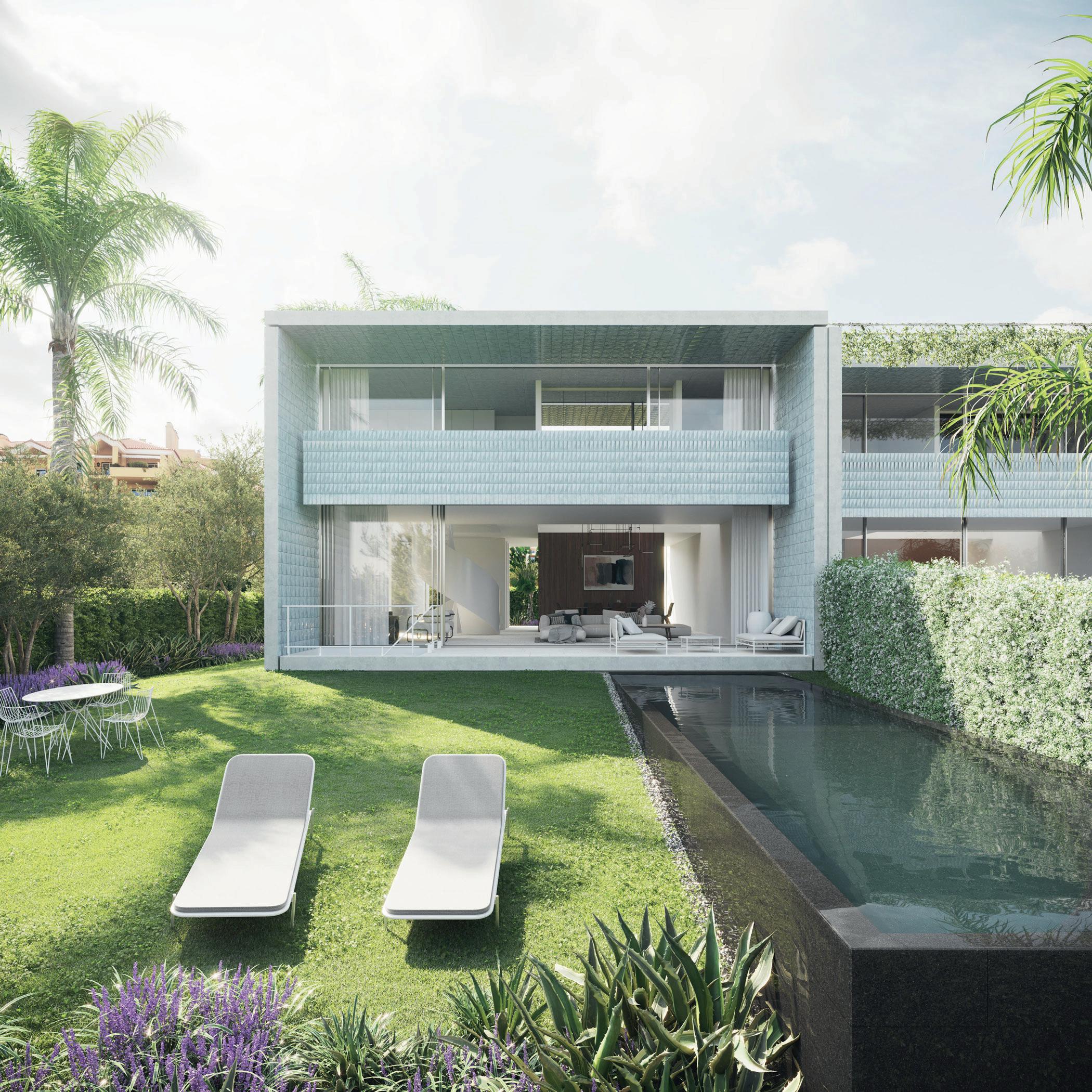





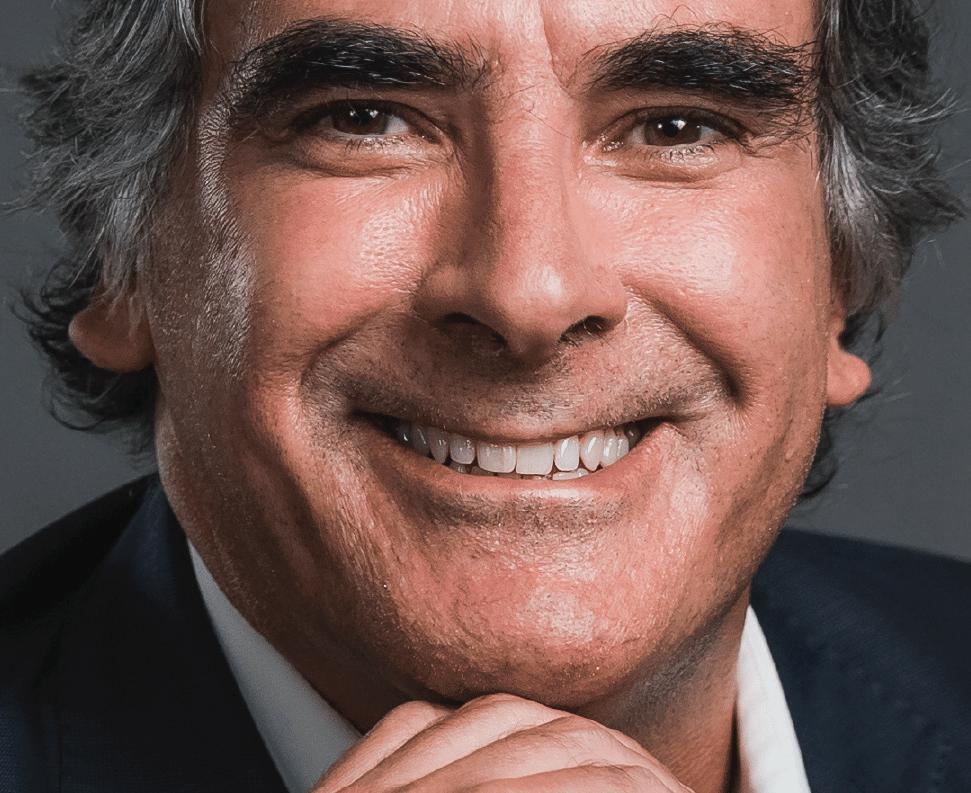

 Sou Miguel Sou Residencial
Sou Miguel Sou Residencial





